
 |
![]()
1970 - 1979
The late 60's leading into 1970 represented the peak of campus protest and unrest, with escalating disruption making a profound impact on every student there. Even the crewhouse - as hidden away as possible - was close enough now as the demonstrations expanded beyond the previous boundaries of campus. The Seattle Times, in their 1996 Centennial Series, documents this time on campus and the streets of Seattle in the article Outrage and Rebellion.
Meanwhile Dick Erickson was not-so-quietly pronouncing it business as usual at the Crewhouse. The middle of Lake Washington was about as far as one could get away from the distractions and Erickson liked it that way. He also liked to plan for the future, and as such his own values would ultimately shape the coming decade. Competition in far-off lands - a dream that had come true for him as an athlete - was high on his priority list, as well as re-invigorating the sport in a city that had been so supportive in years past.
Hard to know whether the vision he had of what rowing could be at Washington - and in the city of Seattle - was how it exactly played out, but by the end of the decade it was Erickson who had built Opening Day into a showcase for the sport, re-established Women's rowing at the University, and taken his crews to four different continents to race. Not unlike Conibear himself, Erickson shared many of the same personality traits: passion for the sport, passion for teaching, part crew coach, part salesman, part evangelist, part enigma. And like Conibear, he ultimately, fundamentally, changed the course of rowing at Washington.
But for Erickson, out in the middle of Lake Washington in the spring of 1970, there was also the season ahead to consider. And with a returning nucleus of experienced young men, the goal was simply to "compete with the best".
![]()
1970
Back to the Firs on Lake Whatcom for the spring break camp and a return to Seattle to finish the week with Class Day, where the seniors prevailed in a close race over the sophomores.
The first test for the team came on the Estuary against Cal, where they defeated a Bears program really struggling now in the climate of the times on the Berkeley campus. The Husky varsity won by over two lengths, the freshmen by over four, but the Cal JV's stayed with the Huskies all the way down the course, Washington crossing the line by a half length.
Meanwhile, Dick Erickson had been working with the Seattle Yacht Club and Seafirst Bank (now Bank of America) to tie crew races into the annual boat parade on the Montlake Cut. UCLA, the top protagonist of the Huskies on the west coast for five years, accepted Erickson's invitation to participate in this unknown and untested event that would become known simply as "Opening Day".
On May 3rd the event went off on a sunny day in front of an estimated 50,000 fans lining the log boom and the Montlake Cut. The JV's, in a furious finish, came from behind to defeat the Bruins by about a half length. In the featured event of the day, UCLA shot out of the gate to lead early in the race with Washington getting a typically slow start, then slowly drew away, leading by six seats with 500 meters to go. But at that point the Huskies began to sprint, rapidly closing the lead. The crews crossed the finish line almost dead even, both timed in 6:04.9, but there was enough margin to call UCLA the victors. Jerry Johnsen, Washington class of '64 and now head coach at UCLA, noted "it's nice to come home to a city that knows what crew is and get a welcome like this before such a big crowd." Dick Erickson was notably silent (at least publicly) other than to call the first time event a "majestic site".
At the Western Sprints two weeks later at Long Beach, on a blistering day with the temperature reaching close to 100, the opportunity for revenge was at hand. The frosh began the day by winning by open water over UCLA. The JV's then had another incredible race, like Opening Day, coming from almost a length behind in the last 500 meters to draw even with OCC; this time the judges proclaimed the race a tie. The varsity got a much better start against UCLA, leading in the first 500 meters, but the Bruins moved ahead in the middle of the race and then out-sprinted the wilting Huskies to the line to win by about a length. "UCLA just has a fine crew, we've got to accept that" said a very disappointed Erickson, losing the featured Sprint race for the first time in his career.
Erickson mostly stuck with the same players for his IRA crews, but workouts were intense and he did shift guys around, including the move of Cliff Hurn out of the middle of the boat to the stroke seat. The team left for the IRA's three weeks later with more confidence and a boat that was going faster than it had all season. UCLA did not take a team to Syracuse due to final exam conflicts.
Lake Onondaga was in prime form upon arrival, a steaming warm amalgam of algae and pollution so thick that it stuck to the oars, the smell wafting over the lake like a toxic cloud. All three teams advanced to the finals on June 13th where the freshmen finished second by about two seats to a streaking Brown squad, and the JV's fell by less than a half length to Pennsylvania. With two very close second place finishes Erickson was now seething on shore.
The varsity got a slow start and was behind in the pack in the first 500 meters. Pennsylvania, the three-time defending champion, was out early and up by a length, but were over-stroking the competition in a series of flutters. The last one - with about 800 meters left - was a fifteen stroke burst at a forty-four, answered by Washington with a power twenty that brought the Huskies rushing past the now fading Quakers. In the sprint to the finish, the Huskies, boosted by the adrenaline of moving so quickly through the favored crew, rapidly pulled away from the pack to win by open water over Wisconsin and then Dartmouth, Penn fading to fifth.
"Oh my God. It's been a long time." That is what Dick Erickson said, and it is hard to know whether he was referring to the series of losses earlier in the season or the twenty year hiatus Washington had taken from the top rung of the IRA. Probably a little of both. And to round out the hardware heading for Seattle, Erickson's team received the Ten Eyck overall trophy by virtue of two second place finishes and a first in the major events.
The coach came home and tried to organize a last minute trip to Henley but the famed regatta was only two weeks away by then. Instead, by virtue of the IRA win, the crew (with Dwight Phillips in for Jim Edwards at coxswain and Fred Schoch replacing Mike Vierick) continued to train for the national trials in late August to represent the U.S. at the FISA World Championships (recently established in 1968). Erickson secured summer jobs for the men, who trained in the morning, worked during the day, then trained again in the afternoon from late June through mid-August. On August 15th, in a tune-up race, the men squared off against UBC on the Cut and won, although the race was stopped midway due to the crews becoming entangled and then re-started. They then followed that up with a race against New Zealand on the Oakland Estuary.
Days later at the trials on the Cooper River in New Jersey, the eight finished second behind Vesper. The only consolation was that they finally defeated UCLA, their nemesis all season, who finished fourth. Erickson then quickly re-shuffled the line-up and entered a four into the trials the next day, and this time the men earned the right to represent the U.S. at the World's with a come from behind victory (and another National Championship, this time in the elite class). At the World Championships at St. Catherines on September 2nd, the team advanced through the repechage to the semis, but finished fourth and did not make the finals.
Only under Dick Erickson could a season start in early October and end in early September, and include a new regatta in front of 50,000 fans and end with not one but two National Championships and a trip to the World Championships. It was a breathless season of high highs and low lows - and the next one started in about three weeks. Hang onto your hat.
An early sample of the 1970
varsity, bow to stern: Brian Miller, Greg Miller, Charles Ruthford, Dave White,
Chad Rudolph, Cliff Hurn, Rex Thompson, Brad Thomas, Dwight Phillips (cox).
Tyee photo.
 The
UCLA varsity celebrating the victory on the Opening Day... the first Opening Day
of boating season that included crew races. Within a few years the races would
become a major draw, fans jamming the Cut in the 70's and 80's leading to
Windermere becoming the sponsor in 1987. Note the finish line, in 1970, was at
the Montlake Bridge, where fans watched these two exceptional crews row neck and
neck into one of the closest finishes in the history of this regatta.
Washington Rowing photo
The
UCLA varsity celebrating the victory on the Opening Day... the first Opening Day
of boating season that included crew races. Within a few years the races would
become a major draw, fans jamming the Cut in the 70's and 80's leading to
Windermere becoming the sponsor in 1987. Note the finish line, in 1970, was at
the Montlake Bridge, where fans watched these two exceptional crews row neck and
neck into one of the closest finishes in the history of this regatta.
Washington Rowing photo
The varsity pulling away
from the pack to win the IRA crown. Pennsylvania was favored to win this
race and had gone undefeated on the season; their trademark was a series
of flutters, where they would bring the rate up from a standard pace (35-37
strokes/minute) to a 42-44. By doing so, they had successfully taken the
lead before 1000 meters in their previous races and cruised to victory.
The Huskies knew this, and had planned to counter each flutter
with power tens or twenties. The strategy worked; by the last
flutter 1500 meters in, Penn was out of gas, and the Huskies poured it on to win
by over two lengths. Listen to Cliff Hurn describe this race, and
also what Husky Crew has meant to him over the years:
Listen: Cliff Hurn
and Husky Crew.
Dick
Erickson Collection photo.
The agony of victory, left to
right Larry Johnson, Brad Thomas, Brian Miller, Chad Rudolph, Mike Viereck, and
Rick Copstead. Dick Erickson Collection photo.
An animated Dick Erickson with Greg Miller, left and Brian Miller, right. Erickson was already frustrated with the timing of the IRA's and the conflict with final exams. "We came very, very close to not coming this year," Erickson said before the regatta. And he was also saying "There's just no way we'll be back. This test week thing kills us." Apparently he changed his mind after the team's performance a few days later, but the writing was on the wall. Dick Erickson Collection photo.
The championship crew receives the trophy, left to right: Jim Edwards (cox), Cliff Hurn, Rick Copstead, Mike Viereck, Chad Rudolph, Brian Miller, Brad Thomas, Larry Johnson, and Greg Miller. This was the first win for Washington in the V8 event since 1950. Dick Erickson Collection photo.
From Cliff Hurn: "This one has Rick Clothier (Dick's assistant that year) holding the Ten Eyck overall Trophy. Doug Neil, the Lightweight Coach, is in the picture right between Gregor & Feed (Larry Johnson) white shirt & sunglasses. We had a piano in the lounge & Doug would really pound out the tunes." Dick Erickson Collection photo.
The U.S. 4+ at the World Championships in St. Catherines, Ontario left to right: Greg Miller, spare, Cliff Hurn, stroke, Rick Copstead, Chad Rudolph, Brad Thomas, Dick Erickson; front - Dwight Phillips, cox. Dick Erickson Collection photo.
A less formal picture, Greg "leadfoot", "senor", "gregor", "phiso" Miller practicing his post-victory pose - all nicknames provide by Cliff Hurn - who added this was not the automobile Leadfoot was driving when he was advised by his front seat passenger to "go to the right of the telephone pole".
Choirboys they were not. "We were staying in the dormitory at Ridley College," Cliff Hurn noted in an interview in 2004. "They were playing cricket on the lawn. It was very hoity-toity." Describing (while laughing) an evening - where two of his team members climbed the college bell tower and switched around the cables: "Instead of going ding-dong they were all messed up. Those stuffy (Canadians) gathered all the coaches together and said if they found out who did it, they'd kick the entire team out." (2)
They never found out. Although we are confident these guys consistently added more gray to Dick Erickson's already graying hair. Cliff Hurn story and photo.
The four finishing behind Brazil by a seat in their first heat at the Worlds. Dick Erickson Collection photo.
The 4+ in the repechage, moving
through the Yugoslavs and finishing two seconds behind the Russians to qualify
into the semi-finals. Knocked out of the semi's by New Zealand, Erickson
still said, "This has been a great experience and it's convinced me we must
orient our program to this level and to set our goals higher. These kids
will come back and tell the other oarsmen how much better they can be with a
better mental effort." Dick Erickson Collection photo.
Harrison "Stork" Sanford
(Washington '26) retired as head coach of Cornell after the 1970 season, and is
seen here in the spring of 1971 with Dick Erickson and the IRA Varsity Challenge
Cup - won by the Huskies in 1970 - at the Firs in Bellingham.
Sanford's Cornell teams won four straight IRA Challenge Cups between 1955 and
1958, with his 1957 team going undefeated with a win at Henley in the Grand
Challenge. It was partially due to that Cornell Henley trip that the door
was opened for Al Ulbrickson to take his crew there the next year - a team that
included a young Dick Erickson (see 1950's).
Stork Sanford, who Rusty Callow described as his greatest oarsman at Washington
(see
1920's),
died in 1999 at the age of ninety-six. Dick Erickson
Collection photo.
Even early in his career, Erickson's vision and tireless energy translated directly to the men he coached. Dick Erickson Collection photo.
![]()
1971
Three weeks after Erickson and his men had returned from the world championships in Canada, the coach was back welcoming, along with his frosh coach Lou Gellerman, a new freshmen class and a solid group of returning varsity oarsmen. Fall turnouts were in the afternoon and were again augmented by increasingly intense weightlifting under the watchful eye of Harry Swetnam, Erickson's right hand man for training techniques and development.
Morning workouts in the winter culminated at the Firs in Bellingham for the now traditional spring rowing camp on Lake Whatcom. The juniors won the Varnell Trophy on Class Day to finish up the training season and point the team toward collegiate competition.
After a sweep on the Dexter Reservoir at Eugene over OSU, Stanford and Oregon on April 17th, Erickson felt "both crews (varsity and JV) are slower at this stage of the season than last year". The team had two weeks to prepare for California and Opening Day, and turnouts still did not measure up to Erickson's expectations, which was made clear to the men.
But the races on Opening Day were not close. Spurred on by the large crowd, Washington won the varsity by three lengths, the JV by four lengths, and the freshmen by four lengths. "The crew performed superbly... they were under a lot of pressure from the big crowd but they rowed better today than they have in practice all spring."
A week later, on the Long Beach course, the men, with Bill Byrd moved into the stroke seat, faced off in a dual race against UCLA for their first real test of the season. Aided by a flood tide and a tail wind, the team stayed even with the Bruins through the first half of the race and then just pulled away, winning by open water over their west coast rivals in a course record 5:51.7. "That course is like rowing down a gutter" said Erickson of the debris laden course. "Dwight Phillips did a great job...there were beach balls, beer bottles and he steered right through it."
Two weeks later the team would meet UCLA for a re-match on Lake Washington on the Seward Park course for the Western Sprints. After a dominating win a week earlier in the Steward's Cup on the same course over UBC and OSU, the team was ready. "Be as hungry as you can. Don't just win. Be hungry" were Erickson's parting words to his crew as they made their way to the starting line. Privately, in an interview with Sports Illustrated covering the Sprints, fittingly titled "Lurch, Wobble, and Gobble Them Up", Erickson noted "we are not the epitome of rowing perfection." But he also noted that this crew was the "best one I've had".
The crew had to fight off a hard charging UBC crew in the later stages of the race, but kicked it into gear to win by a length and half. The lightweight varsity, nicknamed the "fighting lightweights" by their coach Rick Clothier, finished an undefeated season by open water over UCLA. The JV's won their event convincingly, and Gellerman's frosh won by open water to complete the first sweep at the Sprints since 1965. It was a dominating performance and set the team up as favorites heading into the IRA.
In Syracuse on June 19th, on a sunny day perfect for rowing, the varsity got a typically slow start. But by the 1000 meter mark, they had advanced to second behind a surprising Cornell team. Cornell - winner of just one race the entire year and who finished dead last in their first heat at the IRA - held off the Huskies until the final 300 meters. In a rush to the finish line the Huskies brought the stroke rate higher and crossed needing another 100 meters - Cornell won by .8 seconds. It was a stunning win by an underdog Cornell team that had just swapped out of a Pocock shell into a Stempfli a few days prior to the race. Both the Husky freshmen and JV's fell short in their races to complete a disappointing Saturday at Syracuse.
The Pan Am trials and elite National Championship offered an opportunity at redemption for the team. Held three days later on Lake Onondaga, they faced off against Steve Gladstone's Harvard lightweights, Vesper-Penn, and two other composite "all-star" crews (Cornell dropped out after losing two of their members). "The Harvard lightweights had a lightning fast start," said Dwight Phillips, "but we started to bring them back in by the 1,000. Vesper did their flutter and made a move on us, but we knew they would do that and were confident we could move back on them, and we did with a power 20." The final 500 meters was close, Washington and Vesper separating out of the pack and racing to the wire, Washington prevailing by about a half length. "Well, we're not collegiate champions but we are National Pan-Am champions" said an upbeat Erickson.
Lake Calima, site of the 1971 Pan-Am's, is located 4,950 feet in the Andes mountains, ninety miles north of Cali. The road trip in from Cali was harrowing, with the team gawking over the cliffs of a winding mountain road for three hours before arriving at their pre-fabricated concrete hut located on the water. Shadowed by the towering mountains, with security provided by paramilitary forces with sub-machine guns, the scene resembled something out of an Indiana Jones movie.
On August 2nd, the crew rowed in the final against Mexico, Argentina, Canada, Cuba, and Chile. The race figured to be between the Americans, Canada, and Argentina. Argentina used the strange race configuration (holding different events on different days) to their advantage, moving their star athletes around, including the reigning world singles champion Alberto Demiddi. The Argentine eight subsequently stole the show, stroking smoothly with the elite perfection of their moniker - "the golden boys" - and won by nine seconds over the second place Huskies. "Under the circumstances, we felt grateful to get a silver medal" said Erickson. "Argentina was clearly superior. If we had raced for five consecutive days, we would have lost all of the races." He told his crew "Smile and enjoy it - we have learned a lot here".
Once the initial disappointment had subsided , enjoy it they did. The medal was the first in international competition for Washington since the 1952 Olympics - the first in eight-oared since the 1936 Olympics - and would also be the last U.S. National Team Championship eight-oared event represented by a collegiate team. Now all they had to do was get out of the Andes in one piece. Like Indiana Jones, they did that too.
1971 Class Day, the class of '72 taking the Varnell Trophy, left to right: Cliff Hurn, Rick Copstead, Larry Steele, Chuck Ruthford, Jan Karlstrom, Jon Buse, Rex Thompson, Bill Byrd. HRF photo
Dick Erickson, already striking a pose that would become familiar to every oarsman throughout the 70's. Dick Erickson Collection photo.
At Long Beach after a decisive win over the Bruins, front row: Al Erickson '82 (age 11 and already wearing Husky Crew Gear) and Rick Copstead; middle: Charles Ruthford, Dwight Phillips, Jon Buse, Greg Miller, Cliff Hurn; Rex Thompson in the back, and trainer Harry Swetnam in between Jon & Greg. "We raced on a canal... named Baloona Creek... and it was tidal water and I recall having to steer around some logs and large chunks of debris during the 2K race...a coxswain's dream," Dwight Phillips, tongue in cheek, said years later. HRF Photo added 2/21
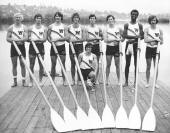 |
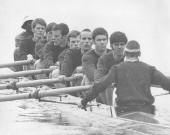 |
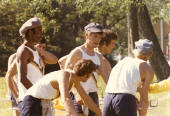 |
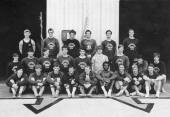 |
The 1971 Lightweights, still considered one of
the strongest lightweight teams in the history of the program. Photos: Paul
Julien and HRF; added 2/21
The famous "Lurch, Wobble, and Gobble Them Up" photo (and 70's era rowing poster on every high-schoolers wall) immortalized by Sports Illustrated in May 1971 of the UW Varsity 8, in one of the most appropriately titled rowing articles of all time. Slow off the start - in fact barely held together - this team mowed down the field once they settled into the body of the race. "There are two kinds of strokes," Jon Buse said of his teammate, Cliff Hurn. "Those with great rhythm, and those who refuse to lose. Cliff was definitely the latter. As the races got longer, he got stronger." (2) Dick Erickson Collection, added 2/21
A pre-race huddle before the IRA final, left to right Greg Miller, Cliff Hurn, Charles Ruthford, Bruce Beall, Fred Schoch, Rick Copstead, Jon Buse, Dick Erickson, Pete Suni. Both Jon Buse and Cliff Hurn were "tall timber" walk-ons from Snohomish County - both from timber families - Jon's wife Vonda saying after the team was inducted into the UW Hall of Fame in 2004: "they both had sawdust in their veins." (2) Cliff Hurn photo.
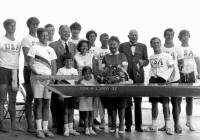 |
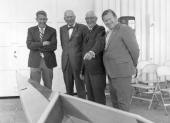 |
Far photo: The christening of the state-of-the-art
"cedar speeder" Tom McCurdy '52 with the
McCurdy family, and the '71 Pan Am Team prior to the team departure for Cali.
The shell did not make the trip to Colombia, instead the team took the placard
(being held by the McCurdy boys) to place on the borrowed USA shell at the
Pan-Am games. Nearest photo: Coach Dick Erickson, Horace W. (HW) McCurdy (friend
and benefactor to the program for many decades), George Pocock, and UW
Athletic Director Joe Kearney enjoy a smile together at the same event.
It was two years earlier at the
1969 National Rowing Hall of Fame Dinner - where HW McCurdy was being inducted
by his long-time friend and HOF member George Pocock - that McCurdy asked George
to begin writing down his memoirs. George originally balked at the idea, but
told McCurdy that night: "If it should ever be done, I know what I should like
the title to be. To me the most stirring words of all are the ones the
coxswain barks as the oarsmen flex their muscles and the starter raises his
arm... and in every shell eight hearts beat as one: Ready All!" (1).
Dick Erickson Collection, added 2/21
"In the summer, pre-Pan Am Games and Dick's
attempt at some therapeutic rowing," said Dwight Phillips.
Dick Erickson Collection, added 3/21
The 1971 Pan Am Trials in Syracuse in a winner-take-all final, the Huskies crossing the line in 6:01 to earn the trip to Cali. Coxswain Dwight Phillips remembers: "Dick and I had a very open pre-race discussion about race expectations and race strategy. There were no prelims... it was a one race final, with the three “seeded” crews next to each other; the Harvard Lightweight crew (coached by Steve Gladstone), us, and a composite crew racing as 'Penn-Vesper'. Gladstone’s team had not lost a race in 2-3 years and were really good and Dick warned us they would be very fast off the start. He also told us Vesper would try a mid-race flutter and 'jack the rate up to 40+' for twenty strokes so to watch for that.
To Dick’s credit, we were ready and confident. As everyone knows now, we were notoriously mediocre in the first 500m... both Harvard and Vesper went quickly into the lead and we were third approaching the first 500m. After we settled in we passed Harvard, and then set our sights on Vesper who were leading by 3+ seats nearing the 1000m.
As expected, Vesper did their rate flutter, moved further ahead and then we strategically countered with power, not rate, when they brought their rate back down. This was the defining moment of the race… we gained back the full deficit and emotionally felt “we CAN win this.” The final 400m was a powerful, confident, controlled sprint… winning by 1/3 boat length.
Dick was often one to deflect coaching accolades but candidly he provided us key pre-race intelligence which we used… and it worked." HRF photo, added 10/22
The official program of the 1971 Pan-Am Games. The main games (track, swimming, boxing, etc.) were held in Cali, with the rowing venue about 50 miles up and into the Andes Mountains at Lake Calima (4,950 feet elevation). Bruce Beall: "After the races we were in a hotel in Buga (about 5 miles from Lake Calima). Our Spanish wasn't great, but the people were so friendly... one guy invited us to his house where we played a horse-shoe like game where if you hit these small paper packets, they would explode (filled with gunpowder). There were kids all around us and they treated us like celebrities. I was a sophomore in college - it was an amazing experience for someone my age." Cliff Hurn scrapbook.
The team at the Cali race course. Cliff Hurn: "We stayed at an abandoned military installation, in the barracks. Each country had it's own small building. Fortunately they fumigated before we got there - I found a "small" scorpion under my bunk (2-1/2" long). The Canadians got there early and were lounging when a bunch of guys in military uniforms & masks came to fumigate with DDT... not sure if they asked in Spanish for the team to vacate but they just started spraying. The guys were jumping out of the windows to escape." Photo from the scrapbook of Frances Mast, (crewhouse cook)
The 1971 Pan Am Games silver medalist eight on the Conibear apron, back row left to right: Cliff Hurn, Rick Copstead, Fred Schoch, Charles Ruthford, Pete Suni, Bruce Beall, Greg Miller, Jon Buse; front row: Harry Swetnam (boatman), Rex Thompson (spare), Rick Clothier (Asst. Coach), Dwight Phillips (cox), Bill Byrd (spare), Head Coach Dick Erickson. "After winning the Trials we were in a hotel in Miami with the full USA team being fitted for our dress uniforms for the Opening Ceremony," said Phillips. "I stepped into an elevator and the two athletes with me introduced themselves as Steve and Frank... it was Steve Prefontaine and Frank Shorter." WRF photo
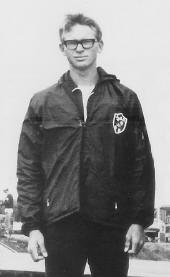 |
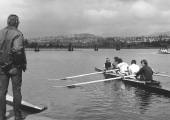 |
Greg Miller '70 was a member of the 1970 IRA National Champion V8 (and selected as the spare to the 1970 World Team) and a member of the 1971 silver medal winning Pan Am crew (as a 5th year senior), but not for his height or weight or physicality; he made it there for his complete dedication to his teammates, and his unwavering toughness. "Greg was incredibly tough, had this ferocity to his rowing and erging... there was no quit in him, he really stood out in that way," said teammate Bruce Beall.
"He was the consummate team guy because he was the silent, hard working guy in every boat regardless of whether the boat was the 1V or the 3V," said Dwight Phillips. "As a cox I always cherished having Greg in my boat, because I knew we’d be competitive in all the pieces... in short Greg was one of those guys who clearly made boats better."
After graduation, Greg became the boys head coach at his high school rowing alma mater, Greenlake Junior Crew, where his coaching and teaching skills were ahead of his time, especially as a young man in his twenties. He inspired hundreds of young men to become better athletes and better people, his calm demeanor coupled with a strong desire to see his teams improve. I would know: that is me (Eric), as a 70lb high school freshman coxswain after my first rowing win, in the Novice 4+ event at Burnaby Lake in 1975, with Coach Miller the first one at the dock to congratulate us.
Greg was tragically killed in a home violence incident while working in ministry in the 80's. But his memory and dedication to this sport live on through his teammates, and the many young men whose lives were positively and permanently influenced by his teaching. "The strength of the bonds that come from rowing are unlike anything else in life," said Bruce Beall. "There’s just something special about crew guys. Rowing is not always easy, its not always good. But it is always reliant - every day - on other people, and you improve with other people, and you come to trust and believe in other people. It’s incredible, it's an incredible sport."
Photos: Dick Erickson Collection and Tom Cohen; added 2/21
1) Ready All!;
George Yeoman Pocock and Crew Racing; Gordon Newell, pgs 151-152
![]()
1972
The highlight of the Lake Whatcom camp was the standing ovation given Fred McElmon - class of '04 and the first name on the Big "W" board - as the guest of honor at the Parent's Night banquet in Bellingham. Still active, the spry eighty-eight year old laughed and joked with the coaches and team throughout the evening. Want to read about Fred and his crews? Click here ---> 1900's
The juniors won Class Day by a half second over the seniors on April 1st, and the season was officially underway three weeks later at Corvallis. The varsity won but only after coming from behind on a rain-swollen Willamette. The best race of the day was turned in by first-year coach Rick Clothier's freshmen, who won by over five lengths.
On April 29th the men swept the Bears by open water in every race. "They really busted out" said Erickson of the pent up energy his crews had before the races.
OSU and UCLA came up for Opening Day on May 6th and the Huskies scored another sweep, winning the featured varsity event by six seconds over OSU with UCLA trailing. One week later for the Steward's Cup it was the same story, with the Huskies scoring an open water sweep over OSU again and UBC.
The Sprints were held at Long Beach. Erickson was frustrated with the poor equipment on hand (the team was borrowing shells) and the lane selection process on the wind blown course and was outspoken in his dissatisfaction. On race day the freshmen powered to an open water victory with a strong California crew pushing them down the course; this was the best finish by any eight-oared California crew since 1966 at the Sprints and put the competition on notice that the storied program was on the rebound.
The JV's could not shake OCC and lost by about a length, but the varsity prevailed over the only other undefeated varsity crew on the west coast, a strong Long Beach State squad. The Huskies jumped out to an early lead and were up by almost a length when Long Beach State, cheered on by the partisan crowd, closed on the Huskies in the last 500 meters. Washington sprinted as well, and finished a half length ahead. An excited Erickson said "We passed the maturity test today. We had to reach down where we live to pull it out. Our guys knew they would have to pay the price this time and the beauty of the thing is that they went out and did it."
The IRA's were moved up in 1972 to the first weekend in June. East coast schools, on a different school year than the west, had long complained of the two to four extra weeks after school was out that ate into summer schedules. Now with the 1972 Olympic team being chosen at a national camp, it gave them the opening to bump the race up two weeks to allow the men more time at the camp. But this change now put the race right at the end of spring quarter - and finals week - at Washington, a move opposed by Erickson.
The men begged off their Professors and maneuvered their schedules and set off for Syracuse. On June 3rd the frosh began the day finishing fifth in a disappointing finale to their previously undefeated season. The varsity got off strong but so did Pennsylvania, moving out to a length lead. With 500 meters to go the Huskies were in second - and moving - but by now were completely spent, and were passed into the finish by Brown and Wisconsin and limped into fourth.
But the JV's had the race of the day for Washington. The crew, a makeshift JV boat that had seen wholesale changes in the weeks prior to the race, got a good start and opened up a lead on the pack through the halfway point. Stroking within their race plan, the team entered the final 500 meters trying to hold off a streaking Wisconsin crew, who moved into the lead in the last 200 meters. With ten strokes left the crews poured it on, and in a photo-finish Washington won by "the diameter of a bow ball" said an elated Dick Erickson. Mike Bronson, the stroke did a "whale of a job" said Erickson. "That was a real gut-check." OCC, victors at the sprints two weeks previous, finished sixth.
The Olympic camp, held at Dartmouth, was led by head coach Harry Parker of Harvard. Dick Erickson was an assistant. Forty oarsmen - of which eight were from Washington - and thirteen coxswains had been pre-selected to attend the camp. In the cut down to eighteen, Jon Buse, Greg Miller, Chad Rudolph, Chuck Ruthford and Dwight Phillips all made it (over half of the remaining men were former or current Harvard oarsmen). In the final cut, both Rudolph and Ruthford made the coxed four. Many of the men went on to race at the trials in straight fours and pairs, with Phillips, Cliff Hurn, and Bruce Beall coming the closest, finishing second at the trials and missing out on an Olympic berth by one place. Miller, who teamed with other Huskies for the straight four but lost in the prelims, said "We can't get a job. Who's going to hire anybody who is going to be on and off the job? I have a very understanding father..."
Ruthford and Rudolph ultimately finished fifth in their event in Munich on September 2nd, with Parker's camp eight winning the Olympic silver behind the famed 1972 New Zealand team.
The 1972 captains, back row Jon Buse and Cliff Hurn; front row Chuck Ruthford and Dick Erickson. Dick Erickson Collection photo.
The JV's, far lane, winning the Kennedy Cup by inches over a straining Wisconsin crew. Dick Erickson Collection photo.
Same photo as above, but as a scan with more detail. UW Rowing photo
The 1972 National Champion JV crew, left to right: Wes Clingan, Bill Mickelson, Mike Cole, Tom Henry, Dick Erickson, race official, Mark Norelius, Dave Reese, Jim Hart, Mike Bronson. Front: Jim Maxwell (cox). The 1972 team was the last Washington team to compete at the IRA Regatta for two decades. Dick Erickson Collection photo.
![]()
1973
The first "Head of the Lake Tournament", as Erickson called it, was held in the fall of 1972. The three mile course, with racing beginning in front of Conibear Shellhouse, was modeled after the Head of the Charles Regatta and featured turns around buoys and staggered starts. UBC, Western Washington University, and other crews participated in this event in November.
The other major event of the fall of 1972 was the "recommended" policy of the NCAA to eliminate athlete-only housing on campus. Joe Kearney, the current athletic director at Washington, asked the Pac-8 (the precursor to the Pac-10, before Arizona and Arizona State were added in 1978) to give the husky crew "special consideration" due to the unique setting and the non-NCAA status of the sport. That consideration was ultimately granted, paving the way for the year-around occupation of the crewhouse by the crew team. The fall of 1972 was the last year the football team (freshmen) lived at the crewhouse during fall quarter. At the time, each oarsman paid $120.00 per month for room and board at the shellhouse.
And more change was brewing: Erickson was looking for opportunities beyond the IRA Regatta. The schedule change in 1972, putting the race square in the middle of Washington's spring quarter final's week, was the final straw. So after training at the Firs on Lake Whatcom, with fierce seat-racing dominating much of the training, the team came home for the annual VBC banquet with 450 alums and friends joining the team in the HUB ballroom. At the banquet, featuring George Pocock as the speaker, Joe Kearney made a "grand finale" announcement to a receptive crowd that the team would bypass the IRA regatta and instead go to Henley - provided that the team won on the west coast.
A week later, the team began their quest at the first annual San Diego Crew Classic on Mission Bay, with a clean sweep over a contingent of crews including Navy, UCLA, Long Beach State, and Orange Coast. They followed that sweep with another against Cal a few weeks later on Opening Day, and finished the season with a dominant performance at the Sprints in Los Gatos, sweeping the regatta by open water in every event. The Henley trip was sealed for the varsity and JV with those wins.
Actually, the Henley trip was a whirlwind of three regattas for the crews, including elite races at Nottingham and Lucerne. In the Nottingham regatta, the varsity finished last in the final behind national teams from Russia and Hungary, although they also finished behind Northeastern and Wisconsin. The JV's had the best race of the day, but finished second to Eastern Sprint winner Harvard by a half length.
At Henley, the varsity advanced through the first round of the Grand by defeating France, but were eliminated in the next round by Russia, the crew that would go on to win the trophy. The JV squad advanced in the Ladies Plate as well, but were defeated by a Dutch squad, with the event ultimately won by the same Harvard team that had defeated the crew at Nottingham.
Disappointed but not deterred, the team went to Lucerne where they finished in the middle of the pack behind East Germany and West Germany, defeating the Dutch and the Swiss.
Meanwhile, by virtue of their undefeated season and a fund-raising drive of the alums and friends, the freshmen went south to Mexico City to compete in the Inter-America regatta. At 7,300 feet high, the Xochimilco course was the site of the 1968 Olympics. In the final, the eight, complete with assistant coaches Bill Byrd and Charles Ruthford as the stroke pair (substituting for two freshmen that could not make the trip), came from behind to win the only gold medal of the games for the U.S.
Dick Erickson said after the
season was complete that "the trips to these fine regattas were very consistent
with what I believe to be the philosophy of the University, the Athletic
Department, and the individual aspirations of the men at the shellhouse.
That is to measure and strive for the highest level of performance."
Although the results were not perfect, certainly these trips fit squarely into
Erickson's now accepted philosophy of creating global opportunities for the men
to compete.
The 1973 varsity team ergometer. You walked into that room mentally prepared or you didn't walk out. Fred Fox scrapbook; added 10/22
Charles Ruthford, Dick Erickson, Rick Clothier, and Harry Swetnam look official for the camera. Erickson made notes in 1969 at the Women's European Championships in Austria regarding elite level racing, one of which read "The team needs a man like Harry Swetnam along to conduct off water training procedures." 1973 VBC Yearbook photo.
January 1973, iced in with glassy, flat water so close... yet so far away. Fred Fox: "I don't know who any of those guys are except I can tell you for sure that is Chris Allsopp with the hockey stick and the skates, he was from the east coast and knew what he was doing, the rest of us did not..." Fred Fox scrapbook; added 2/21
Erickson's goal early on in 1973 was to bypass the IRA. The IRA had always been difficult to work around finals; but now, with the IRA Steward's moving the regatta up to the first week in June, it became untenable given the school year. Furthermore, Erickson wanted to race the best, and that meant racing Harry Parker's Harvard team, a consistent winner at the Eastern Sprints (and a perennial no-show at the IRA's). So it made a lot of sense to use the funds, set aside for three crews to go to Syracuse for a week, towards a trip overseas later in the month.
This picture, of the crews in
the locks preparing to row on Elliott Bay in late winter, was one of a number of publicity
efforts Erickson made in 1973 to build support in the community for this
fundamental change in direction for the program. It worked; the
crews raised enough to not just send the Varsity and JV to Henley, but the
Frosh to Mexico as well. 1973 VBC Yearbook photo.
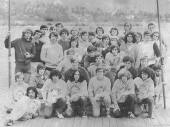 |
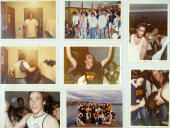 |
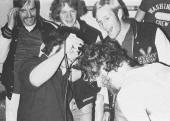 |
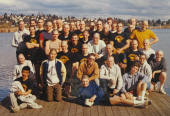 |
Spring break continues to be the most tradition-filled, team-building week of
the year for the Varsity Boat Club, often culminating with the VBC Banquet and
the Class Day races, when alums return home to celebrate the program. Over the
decades the traditions have evolved, but from the 50's through the 90's, the
freshmen head-shaving ceremony was a centerpiece; beginning with inspiring
speeches by celebrated alumni, solemn reflection on the legacy being inherited,
and culminating with the team-bonding tradition of the upperclassmen shaving the
heads of the freshmen. Far left is the timeless "before" picture for the Class of
'76; far right: the "after".
Thank you Chris Allsopp and Fred Fox
(montage photo courtesy Fred Fox's scrapbook); added 2/21
The juniors winning the Varnell Trophy over the seniors. The juniors also won the lightweight event. 1973 VBC Yearbook photo.
The start of the Grand Final at San Diego with Washington - here's a shock - not the quickest off the line. 1973 VBC Yearbook photo.
Varsity coxswain Ted VanBronkhorst goes for a dip. 1973 VBC Yearbook photo.
On the San Diego podium behind a loquacious Dick Erickson, the varsity from the left (per Bruce Beall): "Dave Reese, Noro, Freddy Schoch, Me, Mike Cole, Jocky Joe Buse, Mike Bronson. Paul Julien was also in the crew and Ted VanBronkhorst was the coxswain." 1973 VBC Yearbook photo.
On the shores of the Willamette at the 1973 OSU regatta, Stu Ketchum '74 (cox) and Ike Roesch '75 surround Jim Medlock '73. The jacket Medlock is wearing is actually a JV letterman jacket (W with an oar), often worn in lieu of a varsity jacket (plain W), because the W with the oar through it left no doubt about your sport. In addition, alums will recognize the homemade rigger wrench Jim is holding, tools that were in every boat, and on every road trip. Fred Fox scrapbook; added 2/21
Entering the Cut on Opening Day with the varsity ahead by three seats over Cal; 500 meters later, Washington crossed the finish line about a length and a half ahead. California had a new coach in 1973 in Steve Gladstone, coach of the Harvard lightweights from 1969 to 1972 and already a veteran of international competition. Gladstone assumed the head coaching job from Marty McNair in the fall of 1972. 1973 VBC Yearbook photo.
The 1973 freshmen, left to right: Ross Parker, Stu Johnson, Mark Umlauf, Jim Wiegand, Steve Smith, Mark Canfield, Mark Olason, Chris Allsopp, and coxswain Chris Wells. Photo: Added 7/20/20. Thank you Chris Allsopp.
The
1973 JV's for the Cal Dual. Added 10/8/16. Thank you George Naden.
The varsity, cox to bow: Ted VanBronkhorst, Mike Bronson, Bruce Beall, Mike Cole, Mark Norelius, Jim Brinsfield, Bill Mickelson, Dave Reese, Jon Buse. It was Jon's brother, Mike "Boss" Buse, who wore the original Red Raider helmet. 1973 VBC Yearbook photo.
The
1973 JV's with the haul at San Diego. Added 10/8/16. Thank you George
Naden.
The
1973 JV's at Corvallis. Added 10/8/16. Thank you George Naden.
The
1973 JV's at Henley. Added 10/8/16. Thank you George Naden.
The varsity defeating the French entry in the first round of the Grand Challenge. 1973 VBC Yearbook photo.
The frosh contingent, along with mementos of the trip to Mexico. Collection courtesy George Teasdale.
Chris Allsopp went as the spare to the Inter-America Regatta in Mexico City, and competed in the singles event. He finished third in the final after hitting one of the many large, surface dwelling herbivorous (carp-like) fish in the lake. 1973 VBC Yearbook photo.
![]()
George Teasdale, Manager '73-'82:
Fundraising and promotion was big part of Dick's job in the slow economic days of the 70's. He would hit all the places where the “power hitters” were at - places like Vitos and others down town. As he told me, “I am buying the coach a drink, then another would say I am buying the coach another drink. Then he would hit the next venue. That is why by afternoon practice sometimes he was a bit sedated. It was also why when he needed money for the team he would put on the jacket and tie (remember the chicken-shit-green coat and the faded-pink coat?) and head downtown. I remember him telling me (after picking up the newest Pocock shell ---high value then of $10,000) “George I just picked up a $10,000 new shell and I don’t know who is paying for it. I will have it by noon”. I was having late lunch and I heard him yell, “Teasdale!”. When I looked over to his office he was waving a check at me with a big shit eating grin. A couple of guys asked me what that was about and I related the story. They couldn’t believe it.
Dick would drag me around to the Rotary and Kiwanis club lunches with his “dog and pony show”. He would grab a slide projector, slides, carry projection screen, extension cord and “do dads” (part of an oar, rigger or shell part) and head out the door. He would have me help him get a few things and carry them to the event. Dick would have asked them “what amount of time do you want me to use?” He would tailor things to that time allotment. He would tell me “Eat. Go for the meat. It is a free lunch. Talk to these people about the program and the athletes - God, Country and UW Rowing”. Many of these Rotarians and Kiwanis people would know me by sight later on.
You will remember how we would all be organized to go downtown for a day or two at late morning to lunch with jackets, oars and Crew buttons to raise money in downtown Seattle at a dollar a button. Dick would enlist the press to make a big push about announcing it during the Sports part of the TV broadcast about the “Washington Crew Team being downtown raising money on the street corners”. We all hated it but did it anyway. We would raise $5,000+ that way ( big money then). Business people would be walking past and line up to buy the buttons and pressure their friend to buy one too. I met the girlfriend of the Coxswain (team captain--- “her beau”) of the “first Washington crew to go to Poughkeepsie (National Championship) by steam boat” outside the Washington Athletic Club. She couldn’t afford the $1 (retired). She and I talked for about 10 minutes about Washington rowing and OF COURSE I gave her a button. She was REALLY happy and proud of Washington rowing and the current team. It is a great story.
George
![]()
1974
This would be the first year that the VBC would take over the crewhouse management year around, with the Commodore and Purser responsible for collecting the house bills and forwarding to the Athletic Department. It also would be the beginning of a “golden time” at the crewhouse, where there was often a waiting list to get into one of the rooms there, and where crewhouse law was enforced via lakeshots – even if it meant breaking the ice to do it.
The first major test of the season would come at San Diego against Wisconsin, the defending IRA champion, and a team that had defeated the squad in Europe the previous summer. The varsity got a slow start but by midway had drawn even with Irvine and Wisconsin, and by 1500 meters took a half-length lead. The Badgers made a charge at the end, but the Husky varsity powered across the line about five seats for the win. The JV’s and freshmen also won - and both by multiple lengths of open water (17 and 18 second margins of victory respectively) - to confirm the sweep. “They showed tremendous staging power,” said Erickson of his varsity, “It’s a big day for Washington crew. The big satisfaction was the JV crew. They sold the store. A couple of these guys were violently ill after that... they have been working on crew for four years but had never been in a big race... they had that bittersweet taste of the agony of victory."
Three weeks later, after tune-up racing at Western and Corvallis, the varsity headed south to the Estuary to face an unknown in California, a team that was rapidly improving under second-year coach Steve Gladstone, who chose not to take his teams to San Diego. The freshmen and JV’s continued their west coast dominance with convincing open water victories and the varsity got a decent start, but at 500 meters Cal slowly began to inch away. Even a furious sprint by the Huskies made little headway, and the Bears - for the first time in nine years - won the Dual convincingly by a length, handing Erickson his first loss to Cal in his seven-year head coaching career.
A week later, on a perfect Opening Day, it was UCLA looking for the upset against a now shaken UW squad. The Bruins took the lead early, but two intense moves by the varsity team – at 1000 meters and at the entrance to the Cut – had the Huskies pulling away to a substantial open water victory. Still somewhat under whelmed, Erickson said “It’s still a one speed operation. We’ve had thirteen oarsmen in and out of that varsity shell and we’ve got to find the very, very best combination for the Sprints.”
The governing body for rowing in Canada, Rowing Canada Aviron, built an international rowing facility at Burnaby Lake in 1972. The lake was dredged to make a 6-lane, 2k FISA regulation course for the 1973 Canada Summer Games, the state-of-the-art course complete with a three-story finish tower and extended, permanent grandstands. The site was chosen for the 1974 Western Sprints, where the Huskies would line up as underdogs against Gladstone's undefeated California team. In the Grand Final, California moved out quickly on the Huskies in a replay of the race on the Estuary. At 1000 meters, Cal led by about a half length; but the lower stroking Huskies took a power twenty and moved to even at about the 1500-meter mark, an unexpected move that had the crowd hushed as the crews came in view of the grandstands. As the sprint began it was now a closing Cal Irvine – coached by a young upstart named Bob Ernst and stroked by an even younger Bruce Ibbetzen (2-time Olympian) that drew up to match the Huskies. In the final flurry, Washington’s rate went to forty as the crowd was now on their feet, the Huskies crossing the finish a half-length ahead of Irvine, with Cal third. Erickson called the outcome “very, very satisfying – certainly one of the big wins” in his career.
Earlier in the season, Erickson had finally convinced Harry Parker to come west to meet the Huskies on the Cut. The date was set for June 22nd. “I think it’s going to be a close race, but the onus will be on us to make it close” said Erickson the day before the race.
The freshmen started the day by beating their Harvard counterparts by almost a length of open water to establish themselves as likely the best in the nation (IRA winner Cornell had narrowly defeated Harvard at the Eastern Sprints), with frosh coach Rick Clothier saying “we peaked perfectly for this weekend.” The JV’s had a rough time – crabbing early, coming back, but then failed to move in a twenty at the 1000 meter mark and lost by a length to their counterparts.
The varsity came out hard but could not get a good settle, with the Al Shealy stroked Crimson pushing a solid thirty-five after an excellent start. By the midway point, Harvard was up by three-quarters of a length and continued to cruise, winning the race by a half-length of open water. “This is the best crew I’ve put together,” said Erickson “and they did it to us… we’re pleased with the success of this regatta, but deep down, it kind of bites.”
The only solace Erickson could take was the knowledge that the re-match was already in place for 1975. "Dick deserves a tremendous amount of the credit for creating this event" said Harry Parker. "Maybe we'll even talk them into a four-mile race". In regards to the IRA for 1975, Erickson also added "right now, their schedule doesn't look like it is compatible with ours. They are going to have to make the change. They know where we stand now, loud and clear."
Three Huskies extended their season by making the National Team in 1974, including Chris Allsopp in the double, Bruce Beall in the straight four, and Mark Norelius in the eight. Mark and his teammates surprised the world by winning the gold - a replay of that race is at JAMCO 1974 WRC M8+ Final.
The UW boat bay filled with Pocock red cedar, circa 1974. Fred Fox scrapbook; added 2/21
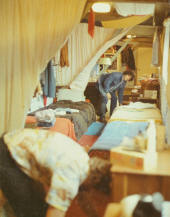 |
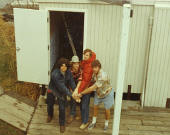 |
The "Conny Quad" (or Husky Hilton as it was known in earlier years) was just another creative solution for the guys to live at the crewhouse together, as they had since the early days of Hiram Conibear when the VBC was first born (1910). The shellhouse was waitlist only in the 70's, so somewhere along the way these guys - from left to right Greg Gordon, Gil Gamble, Fred Fox and Steve Smith - made the launch house storage shed (built out over the water) into living quarters.
Cold, drafty, damp... did not matter, they still paid the $100 a month for food, just like everyone else. "That thing was a disaster waiting to happen but it was quiet and it was ours," said Fred Fox. "We had electric blankets to stay warm, but that probably just made it that much more of a fire trap," he said laughing. "And whenever a coach would start a launch, the whole thing would fill up with 2-stroke exhaust... we just left and came back. Home sweet home." Fred Fox scrapbook; added 2/21
The first 11 minutes of this video, posted by long time US National Team member John Biglow, features the before, during and after of the UW/Harvard race down the Montlake Cut on June 22nd, 1974. A lot of footage of the original Conibear Shellhouse, and many familiar faces in those eleven minutes (including great footage of the late Gil Gamble at the 9:00 mark), but the highlight is the the Class of '77 collecting their medals (about the 9:30 mark) and tossing coxswain John Stillings into the lake. Thank you John Biglow and also to Bob Koch for the link! Added 11/21 |
The Varsity 8 holding the broom after the clean sweep at San Diego, stern to bow: cox Ted VanBronkhorst, Mike Cole, Fred Fox, Jim Brinsfied, Mark Norelius, Dave Reese, Tom Henry, Ike Roesch, and Gil Gamble with the broom. Fred Fox scrapbook; added 2/21
At the Western Washington University regatta on Lake Whatcom, early April, a composite JV/Varsity team left to right standing: Norm Millar '75, Steve Smith, 76, ?, Tom Giovanelli 74, ? , Bill Pearce '74, Fred Fox '76, Ike Roesch '75 with cox Chris Wells. Fred Fox scrapbook; added 2/21
The 1974 JV left to right: Norm Millar, Mark Oleson, Dan Lewis, Tom Giovanelli, Gil Gamble, Steve Smith, Stu Johnson, George Naden, Chris Wells (cox). Husky Crew photo.
The 1974 varsity at Burnaby Lake for the Western Sprints, Erickson moving Brinsfield into the stroke seat due to an injury to Mike Cole (now at six), left to right: Ted VanBronkhorst '74, Jim Brinsfield '75, Fred Fox '76, Mike Cole '74, Mark Norelius '74, Ike Roesch '75, Tom Henry '74, Dave Reese '74, and Chris Allsopp '76. Level with Cal with 500m to go, VanBronkhorst said, "We were really clicking pretty good and flowing nicely and the boat felt good to me. We took the stroke up gradually and in the last 35 or 40 strokes just pulled out the plug and went home... we took it up and danced on out with it." Chris Allsopp photo; added 2/21
The USA Eight - with Husky Mark Norelius in the five seat - crossing the line in a stunning upset victory at Lucerne for the 1974 World Championship. At the finish it is the USA in lane 4, nosing out Great Britain in lane 1 and New Zealand in Lane 6, all three finishing within 1.5 seconds of each other. HRF Photo; added 2/21
![]()
From Jeff "Rollo"
Benedict, '78:
I could go
on for hours about the things I saw and loved about Husky Crew. It is
hard to pick out a couple of them because there are so many of them.
They all involve Dick Erickson because my relationship with Dick was part and
parcel of my relationship with crew. May as well start at the
beginning:
Benedict meets The Coach:
It was fall of 1974 and I was a new freshman at the UW. I had a buddy who had
been invited to try crew and he wanted me to come down to the boathouse and
see if there was something for me to do. First day,
first thing, I met George Teasdale. As I remember it, he looked about
the same as he does now. Asked him what a manager does and he gives me
the rundown. George takes me down to the launch house and shows me a
long, white boat called the Husky. Pretty cool. Has a
straight-eight motor in it, too. Then he goes to another boat, a black
boat he called the Hart Launch. "The main thing a manager does is drive
launches. This is Coach Erickson's launch." He started it up and it had
the throaty roar of a hot rod. I thought to myself, "Works for me." Next
George took me to the Graves Building and introduced me to Dick. George says,
"You'll smell him before you see him." Huh? Hope this Erickson guy takes
showers. Went down a hallway and went in a door. There he was. Sitting
behind a desk with jug ears and short gray hair, with his Sperry-Topsidered-and-white-socked-wearing
feet sticking out of a pair blue and white checked doubleknit dress pants and
resting on the desktop and with a smoke belching pipe sticking out of his
mouth was the man who was called Coach Erickson. I didn't know it at the time,
but this was the beginning of one of the most important relationships of my
life.
Benedict goes to turnout:
The next day, I showed up at the boathouse at 2:00 P.M. like George told me to
do. The freshmen hadn't started going out on the water yet so I was to
work with the varsity crew for awhile. Seems that the guy who usually
drove the launch didn't show up so Coach Erickson asked me to go with him.
"What's your name?" Jeff. "Hell, that will be easy to remember. I have a
kid named Jeff. Ever driven a boat before?" No. "Well, I'll start and you can
drive some in the middle. It isn't very hard." And so it began. I got to
drive the boat a little and Coach Erickson took the helm to put it away. "So,
Jeff, ya gonna come again tomorrow?" Yep. "Good, good. I'll see you tomorrow."
It was a Thursday and the next day was Friday.
Benedict's eyes get big:
I didn't know it at the time, but the crew had what Coach Erickson called 'ham
and eggers' on Friday where the lineups for all the shells are kinda pulled
out of a hat and they go and race. Seems Coach's buddy Charlie
"Pull-Hard" Bower worked at Boeing and fed all the guy's names in the computer
and the computer picks 'em out and keeps reams of statistics and stuff that
Coach liked to look at. Anyhow, on Friday, all the varsity guys show up at the
same time and they took out what seemed like 25 shells and rowed them out to
the Evergreen Point Bridge. Coach Erickson's regular driver showed up
for this, so I just rode in the launch. The sun was low in the sky and I just
couldn't believe the sight I saw as the crews gathered up
for the star of the runs. The guys seemed to be in a really good mood
and were screaming and yelling at each other and staging up like soldiers
going out to battle. Coach Erickson had a big grin on his face. I
must of looked kind of stunned sitting there in the launch because Coach
looked at me and said, "Hey, Jeff! Isn't this f***in' great? Yeah, this is
f***in' great!" I had to admit it. This was f***in' great.
Benedict gets scared but finds out where he stands:
I drove the boat the next week and got more confident. I was worried
about doing a good job because this whole scene really impressed me. Coach
Erickson liked to run the crews up and down the Evergreen Point Bridge and
sometimes he wanted me to squeeze between the side of the bridge and a shell.
This scared the **** out of me but I knew I had to do it. I guess I got
a little close to one of the shells and the guy in the back that they call the
coxswain turned and yelled at me. I felt bad because Coach wanted me to be in
there. I dropped back a little and Coach waved his arm for me to get
back in there. The guy yelled at me again. I didn't say anything to
Coach because I, well, I didn't. At the end of the run, the coxswain, a
guy with a mustache and a blue hat, took his megaphone off and mouthed the
words, "F**k off!" at me as he waved his hand. This was the last run of the
day, so I followed the crews back to the boathouse and put the launch away. As
I walked across the boat bays, the little guy with the mustache and the blue
hat looked at me with a look like he wanted to kill me. I continued to
my car. The next day, Coach did about the same thing as the day before.
When he told me to drive between the bridge and the shell, I said, "Gotta be
careful today. Yesterday, that guy (I gestured at the guy with the
mustache and the blue hat) got really mad at me." Coach said, "He did, huh?
If he does it again, tell him to eat s**t and to come and take it up with me."
I filed that away but noticed that Coach gave me a little more direction as to
how to drive. I learned fast. I just had to please Coach Erickson
and do what he wanted me to do. The guy with the
mustache and blue hat didn't glare at me. I guess I did fine. I found
out that the guy with the mustache and blue hat was a senior, Steve Thomson,
who eventually became a really good friend and one of
the people for whom I have the greatest respect.
Benedict
gets a nickname:
I kept coming to practice and was really enjoying myself. I had learned
to put the launch away without hitting the dock and, in general, Coach
Erickson seemed pretty pleased with me. I would come
to the boathouse a little early each day and noticed that lots of these guys
had nicknames. There was a "Smitty", a "Kebo" a "Woodeye" a "Gilbilly",
a "Sopp", a "Roscoe", a very large, muscular fellow
called "Blimp", a really tall guy (taller than the others) called 'Zoomer" an
"Ike", an "Oly", a "Jay", a "Swifty", a "Stumpy", a "Gordy" and a wild looking
guy with a Land Cruiser called "Lucky Pierre". Lucky Pierre was also a
manager and another guy called "Bomar" was, too. I was walking through
the boat bays going to the shop where Coach held his meetings before turnout
and noticed a curly-haired guy named "Stu" kind of holding forth, telling
jokes and pointing and laughing at the other guys. There was one called "Hess"
that a lot of the other guys would tell to shut up while they pointed and
laughed at him. The one called "Roscoe" asked me loudly, "What's your name?"
This was the first time any one of these guys actually said anything to me.
Before I could answer, the one called "Stu" said, "You look like a Rollo.
Yeah, that's your name. Your name is Rollo". In those days, I was
kind of scared on my feet and, before I
could correct them, the other guys stared saying things like, "How ya doin'
Rollo? Hey, man! It's Rollo! What's happenin', Rollo? Yeah, man!
Rollo's the guy who drives Dick's launch! Guys, Rollo's here! All right, Rollo!".
I didn't particularly like it but I guess my name was now Rollo. This must
mean that they accepted me. How wonderful it is to be liked. Oh, joy.
(For those who forget, Stu is Stu Johnson,'76, Smitty is Steve
Smith,'76, Kebo is Keith Ikeda,'76, Woodeye is Stu Ketchum,'75, Gilbilly is
Gil Gamble,'75, Sopp is Chris Allsopp,'76, Roscoe is Ross Parker,'76,
Blimp is Jim Brinsfield,'75, Zoomer is Mark Umlauf,'76, Ike is Dwight Roesch,'75,
Oly is Mark Oleson,'76, Jay is
Jesse Franklin,'77, Swifty is Scott Hansen,'76, Stumpy is Mike Stager,'76,
Gordy is Greg Gordon,'76, Lucky Pierre is Kirk Knapp,'77 and Bomar is Walt
Hansen,'77. The one called 'Hess' would eventually be Captain of The
Crew and Stroke Oar of The Varsity, Mike Hess, but, at this point in time as I
would discover, he was an inferior subspecies known as a "Rookie".)
Benedict screws up and someone else gets blamed:
One of the tasks of the launch driver is to move rowers from one boat to
another and one seat to another. One week, Coach seemed to be doing seat
changes a lot so I had to learn to do them with confidence. I was very
tentative at first but, with a little coaching, I was doing fine. During one
of the last turnouts of the week, Coach was getting more and more perturbed.
He was trying to get them to move the oar faster through the water and some
guys were having a hard time getting the hang of it. He was getting madder and
madder. He was having me move guys from here to there, there to here, having
shells come together and changing guys around and, to my inexperienced eyes,
it seemed like he was playing a shell game in a
carnival sideshow. I thought, however, that I was doing great. I
was doing exactly what I was asked to do and didn't need to be told how to go
about doing the job any more. Well, I wasn't quite as good as I thought
because, on one of the changes, I came into the shell at a funny angle and
caused Chris Allsopp's oar to disappear under the launch. Sopp was in
the process of being lectured and moved and, because I had pulled the launch
over his oar, he couldn't remove it from the oarlock to take with him when he
moved position. As Coach yelled at him, Sopp pushed the launch away and that
was enough to set Coach off. "What are you doing? Get out of the damn
shell and get on the launch!" Sopp said that he couldn't because the launch
ran over his oar before he could get his oar out, something that I had caused
from my inexperience. Coach's voice went up two octaves as he yelled "THAT"S
THE WHOLE PROBLEM, ALLSOPP! YOU. JUST. AREN'T. QUICK. ENOUGH!" Before he sat
down, he kicked at the bulkhead in front of his seat and then bit the top of
the windshield of the launch, leaving a half circle of teeth marks in the
wood. I didn't say
anything. Too scared. I finished moving Sopp to where he was to go
and Coach turned the shells around and started them back to the boat house.
He sat down and didn't say anything the whole way back. I
guess he was done coaching for the day.
Benedict sees a fight:
Later that fall, almost at the time turnouts were stopped for the fall, Coach
had the crews off of Laurelhurst Beach Club and was having them do a variety
of drills to build rowing technique. The last of these was a funny sort
of drill that they were doing kind of as a goof called the "GZ Paddle". I
gathered that a "GZ" or "Golden Zooker" was a guy who wasn't good enough to be
in the racing boats but was handy to have around as cannon fodder. This drill
involved pulling the oar slowly through the water and then pushing it forward
to take another stroke as fast as possible. This seemed like a very
inefficient way to row but I suppose that is what it was called the "GZ
Paddle". There was a lot of splashing and grunting but not much
movement. One of the hazards of the GZ Paddle is that if one guy comes
forward too fast, his oar handle can hit the guy ahead of him right at the
base of the back. I was right beside a shell with Steve Thomsen (the guy with
the mustache and the blue hat for those who haven't been paying attention) at
cox, Jimmy 'The Blimp' Brinsfield at stroke, Fred Fox at seven, Mark Umlauf at
six and I do not recall who the other people were. Fred came forward a little
too fast and jammed Jimmy in the back. Fred did this three strokes in a row
and, when the boat stopped, Brinsfield turned halfway around and said
something to Fred. Fred said something to Brinsfield and then Brinsfield
stood up, turned around and slapped Fred a couple of times
on the side of his head and then Fred pulled him down and kind of slid back in
the boat and the two of them began fighting in Mark Umlauf's lap. Steve
Thomsen was yelling at them to stop and Coach Erickson said, "Let's get out of
here!" Thomsen yelled, "Where the hell are you going, Erickson???" Knowing my
instructions, I pulled away kind of slowly and watched the fight go on for
awhile as Fred struggled to throw Jim out of the shell and Jim struggled to
stay in. Mark just wanted them to stop. The fight died a natural death and
Coach looks at me and says, "I don't think we'll do GZ Paddle any more." Good
idea.
Benedict grows up:
I could go on and on and on spinning stories about Husky Crew and how it
helped me grow up and become a man. I am grateful that Husky Crew was
available to me at that time of my life. I came in as a self-conscious,
immature kid and came out much different than I was before I started. My
experiences are quite different because of the difference of my job to that of
the rowers but it was the nature of that job which taught me the things I
know. When I left six years later (after graduate school), I was
confident and willing and able to go out into the world and be the person I
was always destined to be. This opportunity has been there for 100 years
for many boys and girls who wanted to be successful men and women. Coach
Erickson was both a product of Washington Crew and a person who passed it on
in better shape than it was in when he arrived. Washington Crew and the
people who comprise it can continue to provide this opportunity to others for
another 100 years and more if we all continue to support and build this thing
which was provided for us. I am going to do my part. I hope you do
yours.
Jeff Benedict, '78
![]()
1975
In the summer of 1974, freshmen coach Rick Clothier announced that he was leaving Washington to accept the head coaching position at Navy. In his place, Dick Erickson hired Bob Ernst, the coach of the Cal-Irvine team that had so impressed at the Sprints at Burnaby in May. Ernst welcomed over one hundred frosh candidates on the first day of turnouts in October.
After the juniors barely eked out a win over the seniors at Class Day, the team got down to serious business at San Diego. “I’ve got no allusions: I don’t think we’re where we ought to be” said Erickson before the race.
But the freshmen won handily on April 5th by ten seconds, and the JV’s startled San Diego newcomer Harry Parker’s Harvard squad, winning by a length in their event. “The JV’s just impressed the heck out of me – those guys really rowed a boat race” said Erickson. But the varsity did not have their best race, finishing second to Harvard by over a length.
Erickson went back to the drawing board, and by Opening Day had arrived on a new line-up to face California on May 4. The weather was one of the nastiest on record, with a southwesterly wind gusting over forty miles an hour and a driving rain, forcing the officials to shorten the course. But Washington swept the regatta, with Cal coming closest in the freshmen event by less than a length; the others won by open water.
Two weeks later the Western Sprints were held at Long Beach. In a bit of a stunner, the Cal freshmen rode neck and neck on the Huskies down the course and prevailed by about two feet. The JV’s, however, won by three-quarters of a length over OCC, and the varsity rowed “the best race I’ve had a crew row. I really didn’t think the race would be that lopsided,” said Erickson of his varsity squad’s ten-second victory in the final. Oregon State finished a distant second in the race followed by Cal.
Off to New London to meet Harvard (who had earlier swept the Eastern Sprints) for the promised distance race on the evening of June 21. In excellent conditions, the freshmen took advantage in their two-miler of a Harvard crab midway through the race to take a two-length victory. The JV’s, in their three-miler, had an excellent start and powered to a dominant six length win.
The varsity lined up for the sweep near the New Haven railroad bridge against a familiar Al Shealy led Harvard squad. The crews stormed out together, but in the second half-mile Harvard moved up by a length, and just held that margin down the course, winning by a half length of open water. “No one ever rowed four miles better than that” said an animated Harry Parker after his varsity prevented a Washington sweep. “I think it is the strongest race any crew of mine has ever rowed.”
And in a scene permanently etched in the minds of every Husky there, the wire report noted “afterwards, a can of beer in his hand, Shealy called the victory ‘decisive’”. Dwight “Ike” Roesch, the humble captain of the Washington team, quietly noted, “it’s become personal”.
And a shame that was. This event arguably featured the two deepest and best crew teams in the nation, fighting it out for the first ever Tom Bolles trophy. Bolles, the former Washington and Harvard coach and the essence of class (see 1930’s), likely agreed with many in the crowd that, from the perspective of pure athletic effort, this was one of the best collegiate crew events seen in many, many years. Had Washington won that race, Erickson planned to take them to Henley. As it was, the Harvard varsity did go to Henley, where they lost in the final of the Grand by two lengths to the British National Team.
Huskies
that extended their season as members of the 1975 U.S. Pan Am team (held in
Mexico City) included Ted VanBronkhorst as an alternate,
Bill Byrd (gold) in the straight four (coached by UW alum Rick Clothier), and Mark Umlauf
(gold) and Mike Hess (gold) in the U.S. eight. Umlauf also rowed in the
U.S. 8+ at the World Championships in Nottingham that finished 5th, with Chris
Allsopp an alternate to the team.
In the fall of 1974, Bob Ernst
became the first Freshman Coach hired at Washington who had not rowed in the
program; not the first - or the last - time Dick Erickson would break with
tradition to maximize the competitiveness of his program. Ernst, with a
strong background in athletics (football, water polo, rowing) and four years
of varsity coaching experience as the head coach at Cal Irvine, had developed
a team at Irvine that in 1974 pushed Erickson's V8 to the limit (Irvine defeating
Cal along the way) at the 1974 Western Sprints. Although Erickson received some
pushback from alums for this break in tradition, within a decade
Ernst would not only prove Erickson's foresight correct as a highly successful freshman coach, but
he would ultimately - permanently and positively - change the rowing landscape at Washington and
beyond. Dick Erickson Collection; added 2/21
Bob Ernst's new fall office, Old Nero in good shape in the Fall of 1974. HRF photo, added 2/23
The Husky Crew rowing schedule for 1975. Erickson and Ernst aggressively recruited high school athletes from the PNW region to walk-on to the team, and mailed out flyers like these to keep the opportunity top of mind for high school senior athletes headed to the University of Washington. HRF photo; added 2/21
The 1975 JV's over Orange Coast for the Western Sprints championship on the Long Beach course. HRF photo; added 2/21
The 1975 Varsity 8, left to right: Ike Roecsh '75, Fred Fox '76, Jim Brinsfield '75, Mark Umlauf '76, Mark Olason '76, Stu Johnson '76, Mike Hess '77, Chris Allsopp '76 and Chris Wells '75, coxswain. Chris Allsopp photo; added 2/21
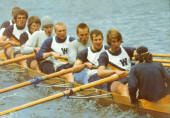 Opening
Day 1975: cold, wet, windy, miserable, the V8 rowing with hats and sweats on.
Bow to stern in a bucket-rigged Pocock: Hess, Johnson, Olason, Umlauf, Allsopp,
Brinsfield, Fox, Roesch, and Wells.
Chris Allsopp photo; added 2/21
Opening
Day 1975: cold, wet, windy, miserable, the V8 rowing with hats and sweats on.
Bow to stern in a bucket-rigged Pocock: Hess, Johnson, Olason, Umlauf, Allsopp,
Brinsfield, Fox, Roesch, and Wells.
Chris Allsopp photo; added 2/21
Picture day 1975, south side of the 520 bridge heading west. Fred Fox said, "Ike Roesch was our captain - just a low key guy, but when Ike spoke people would listen. Zoom (Umlauf) and Blimp (Brinsfield) were the engine room... you could feel the boat lift up when those guys kicked it into gear." HRF photo; added 2/21
![]()
1976
On October 10, 1975, the inaugural Arnold F. “Spike” Eikum regatta – named in honor of the former General Manager of the state ferry system and 101 Club president – was held on Lake Washington. Actually a similar event had gone off a year earlier, but only by accident when the crews, out for an interclass ham'n'egger, happened by a 101 Club "meeting" on the lake. But this regatta featured the entire varsity squad – heavies and lights – split into eights by the coaching staff and sent out to the bridge to race 2000 meters, followed by the yachts of the 101 Club. Now a permanent fall fixture, the winning crew is usually some anonymous group of guys, likely picked to finish dead last by the coaching staff, which prevail over the multitude of shells lining the lake.
By the springtime, Erickson was not sure what he had. Prior to leaving for San Diego, he said "It's kind of scary, especially considering the magnitude of the San Diego Regatta." By now the San Diego Crew Classic had been established as the only event that would pit east (including Harvard and later Yale) versus west, an all-comer's event that would help establish bragging rites for the remaining year. It was beginning to be taken very seriously, and Erickson knew it.
The frosh began the event with a decisive victory over California, as did the lightweights, but the JV's were challenged all the way down the course by a tough Penn squad, and were beaten to the line by less than a second. The varsity, having finished third in their heat, was relegated to an outside lane and was really never in the final, losing to Harvard, Penn, California, Wisconsin, and Navy in that order. Chris Wells, captain and coxswain said "I don't know what to tell you. I think we can row better and can come back. The other crews ran just an aggressive race for this time of the season."
On Saturday, April 24, the crews met a determined Bear team on the Estuary. The freshmen won a close boat race, but the JV’s fell by a length. The varsity race was over at 1500 meters, with Cal leading by open water, when the six man in the Cal boat’s back went out. With only the sprint left, Cal was faltering, and the Huskies, who had abandoned their race plan early on and were scrambling down the course, rowed through to a fortunate win by about six feet.
The U.S. Olympic team, including Husky Mike Hess, came to Seattle for Opening Day the following weekend. The Husky varsity, steadily improving, had one of their better races of the year, rowing close to their under-stroking Olympic brethren and finishing about a half-length behind. The stunner of the day came in the freshmen race, where a polished group of high school students from Brentwood College knocked off the Husky freshmen.
Two weeks later the team re-grouped at the Western Sprints on the San Pablo Reservoir May 15. The freshmen rowed their race, holding off the Bears to win. The lightweights completed an excellent season with a victory. The JV’s, after a tough year, were beaten by Cal and nosed out at the end by OCC. But the varsity, true to Chris Wells' word earlier in the season, attacked the course with a vengeance and finally rowed their race. Understroking both Cal and UCLA, the team saved it for the sprint and moved out to an open water lead as they crossed the finish line. “They rowed the race the way they were trained to row” said an elated Erickson. “They really did what they had to do.”
Unlike previous years – dating back to 1970 – this would unfortunately be the end of the 1976 season as Erickson had nothing lined up for the post-season. Not for California however, as Gladstone took his crews back to the IRA two weeks later and won the Varsity Challenge Cup for the first time in his career. That had to be bittersweet for Erickson and his Sprint champion varsity, the coach vowing not to take his crews back to the IRA’s until the regatta changed the dates. Regardless, this young Husky team, although not perfect, never gave up. The consistent improvement in boat speed, as the season progressed, in the end established this crew as one of the top in the nation.
Chris Allsopp (sculler alt.), Mark Norelius (8+), and Mike Hess (8+) made the U.S. Olympic Team in 1976, competing in Montreal. The eight finished ninth in an Olympics dominated by the East Germans.
George Yeoman Pocock, born March 23, 1891, died at the age of eighty-one on March 17, 1976. Coaxed to Seattle by Hiram Conibear in 1912, Pocock became a trusted friend and invaluable advisor to Conibear, Ed Leader, Rusty Callow, and Al Ulbrickson. Pocock's multitude of achievements are well documented, but the simple quality most remembered by those who knew him - including the thousands of young men who watched him at work - was his open ear to any who ventured into his shop. Art Campbell '12, eulogizing Pocock at the VBC Banquet that spring said, "If he isn't with the angels tonight, none of us will ever get there." A man of integrity and purpose - a man for all seasons - it is Pocock's spirit, then and now, that is forever linked to the spirit of Washington Rowing. Husky Crew photo.
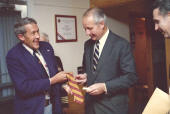 |
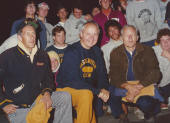 |
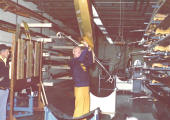 |
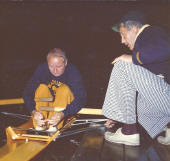 |
In the fall of 1975, Navy
Secretary J. William Middendorf II came to Seattle to pick up a cedar single he
ordered from Stan Pocock. Dick Erickson - who never let a publicity opportunity
go to waste - made sure the team was there to greet him along with the press.
Pictured left to right: Erickson and Middendorf in Dick's office; the team
together (with Stan); and the last two as the Secretary takes his new single out
for the maiden voyage.
Dick
Erickson Collection; added 2/21
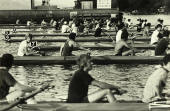 A
little friendly trash-talking before the 1st Annual Spike Eikum Regatta in the
fall of 1975.
Dick
Erickson Collection; added 2/21
A
little friendly trash-talking before the 1st Annual Spike Eikum Regatta in the
fall of 1975.
Dick
Erickson Collection; added 2/21
Opening Day 1976, after the crew races. Dick Erickson Collection; added 2/21
A throwback to the spring of 1973, the Class of '76 as freshmen. Beginning in the 60's and continuing through today, every freshmen class makes a motto with their year in it. In this case: Super Quick in '76. Thank you George Teasdale and Jeff Laband
![]()
From Kirk
"Lucky" Knapp:
I once attempted a solo dock sweep on the entire freshman class...not just any dock sweep. I had a huge beam lashed to the front of my Land Cruiser, which was stashed just inside shell storage. With the varsity on the deck, and the grunts on the dock, the bay door came up and I drove out onto the dock. Some did go into the drink, but a few of them got the hood open and were trying to "disable" me...a hasty retreat was made. Trips through the locks and across to Bainbridge in the Hart launch and HUSKY II, or making Old Nero disappear and driving Dik nuts....Like most of the guys, the more I think about it the more tales I come up with...
![]()
1977
Bolstered by the late success of the 1976 campaign and a solid group of returning oarsmen - including Olympians Mike Hess and Mark Umlauf who had missed the 1976 season - the crew left for San Diego confident. Harvard had chosen not to come to San Diego this year, but instead perennial east coast contenders Cornell, Pennsylvania, and Princeton made the trip.
On April 2nd, on a windy Mission Bay, the freshmen began the day losing a tight race to OCC. The JV’s followed with a half length loss to Pennsylvania, but a tough Lightweight team won by over three lengths to set up the varsity event. In a see-saw race down the entire 2000 meter course, Pennsylvania was ahead by a half length with 300 meters to go. Washington then poured it on, closing to dead even as the crews crossed in the identical time of 6:19.8, with a surprising Oregon State crew finishing third. After scouring the film for what seemed like an eternity, the race officials came back with their verdict: Penn by two inches. “It hurts,” croaked a dejected Dick Erickson.
Two weeks later the crew would face off against OSU on the Willamette. Erickson had his men out in small boats the week prior to the regatta, and then put together a re-configured line-up on the Thursday prior to the race. The result was a crew that had not rowed together, against a polished OSU crew that had defeated defending IRA Champion Cal at San Diego two weeks earlier. The race was close, but the Beavers moved in front with about 500m to go on the upriver course and held on to win by about two feet. “We didn’t get the desired results” said a now perplexed and slightly embarrassed Erickson, admitting the men, coming into the race, did not underrate OSU, “but maybe the coach did”.
So it was now seriously back to the drawing board for a coach that knew he had the talent to go somewhere but had yet to find the magic, a theme that would carry through this season. By the Cal Dual on Opening Day he had settled on a veteran squad that inexplicably jumped the start, causing the judges to stop the race, re-start, and warn Washington. The resultant second start saw Cal moving to an early lead, with Washington finally finding the rhythm to get back to even by 1000 meters. Cal sprinted early and moved ahead again in the early part of the Cut, but stroke Mike Hess took his crew into the sprint at the bridge and the crew powered forward, pulling ahead by almost a length in the final 350 meters to cap the sweep of the Bears by the team.
By virtue of that win in front of the huge Opening Day crowd, Erickson began the campaign to send this crew, and his dominant lightweight squad, to Henley. To seal the deal, both crews would have to win at the inaugural Pac-8 regatta to be held for the first time at Redwood Shores, in a single elimination, dual-race format on May 22nd.
On the day of the finals, it was the varsity lining up again against OSU, who earlier had defeated California in a semi-final to advance. Both teams started strong but the Huskies, under-stroking their counterpart by almost four strokes per minute, put it in gear after 500 meters and drove to a two length win. The lightweights dispatched their finals opponent, Cal, by eight lengths in a time only three seconds slower than the winning varsity time, prompting Erickson to say his lightweight crew was “one of the finest crews I’ve been associated with. They are an incredible bunch.” The freshmen also won, but the JV’s were nosed out by California in their final.
So Erickson would take one of his largest teams to Europe in 1977, but they were not given much of a chance. “Considering the Huskies (varsity) haven’t beaten Harvard in recent memory, the outlook for Washington may not be exactly glittering in surviving as the number one U.S. college crew either. Whatever, it seems ludicrous that it requires a trip to Europe to decide the U.S. collegiate championship,” said the Seattle P-I. As if to add to the uncertainty, Erickson was still tweaking the line-up of his varsity crew once in Europe.
But in a tune-up race at Nottingham the varsity served notice that the crew was ready, finishing second to the British National Team by a half-length and ahead of Harvard (Eastern Sprint champions). An excited Erickson said “we just flat-out out-rowed Harvard. It was a big day for Washington over here. What happened here will really help our confidence as we train for the Henley Regatta.” The lightweight team also performed well, finishing a close second to the British National lightweight team.
On to Henley, where the lightweights, entered in the Thames Cup (an open event not limited to lightweight crews), advanced after winning their first race. In their second race, they were defeated in a nasty headwind, losing to a much heavier crew that powered into the weather. That same day, Garda Siochana (basically the 1976 Irish Olympic Crew), defeated Harvard in the first round of the Grand.
Meanwhile, a group of Washington spares – two lightweights and two heavies – formed a team that began their unlikely quest for the Visitor’s Cup (straight fours) by winning their first round over a favored St. Catherines College. Trailing much of the race, the Huskies moved through the Cambridge school and in the final sprint pulled away to a two and a half length win. The St. Catherines stroke oar collapsed at the end of the race and fell into the water, where members of a launch retrieved him. “What’s so surprising about that win is that this was only the third time the four have sat in the boat together,” said Erickson.
In the Grand Challenge semi-finals, the Washington varsity, which had drawn a bye in the first round, now faced Garda Siochana. The Huskies had a start “that put the fear of God in them” according to Erickson, and veered off course toward the log boom, but settled down and began to row their race. Once back in the race by Fawley, the crews were never separated down the course by more than a few seats, Washington sprinting to win by a half-length. “They rowed for their life today” said Erickson. The headwind and rough conditions played into the Huskies strengths, but Erickson privately worried whether his crew had anything left for the final the next day. The British National Team (rowing as the Leander and Thames Tradesmen) in the other semi-final were also forced to row a tough race, defeating IRA Champion Cornell by only a quarter length.
After advancing through Downing College in the quarters and London Rowing Club in the semi’s, the four was now poised in the final on Sunday, July 3. The crew got a good start, were challenged for the first 500 meters, but then pulled away and never looked back, winning the Visitor’s Cup by multiple lengths of open water over Lady Margaret’s, for Washington’s first ever win at Henley. It was as unlikely a win for Washington as it was a harbinger of things to come.
The final of the Grand was postponed for three hours after the crews had launched, rowed to the start, but then were informed that a broken foot stretcher in the Leander crew needed repair. Back at the tents the men ate cookies. Finally lined up at the start hours later, the crews were forced to wait again, as a flock of geese were escorted off of the course, the uneasy tension broken by friendly conversation among the opposing crews – a scene not uncommon at Henley.
As the starter's flag dropped, Washington exploded off line, settled, and began to move to a half-length lead by the Barrier. Leander took a move, but the Huskies answered and began to pull away in earnest, and by the time they were in front of the enclosures were up by a length and cruised home to win the Grand Challenge in 6:27. “We decided that if we got ahead we were not going to let them back. This is the one we’ve been working for all year,” said Hess.
On July 9, the crews rowed at Lucerne against more international competition, this time being defeated by the East and West Germans, the Russians, Bulgaria and other national teams, finishing ahead of the only other American crew entered, Cornell. “We found out how deep the water is,” said a humbled Erickson.
But he also knew that regardless of these results, nothing would tarnish the legacy of the 1977 team as the first - and second - Henley Champions at Washington. Yes, maybe it was "ludicrous" - as the P-I noted earlier - to choose a national champion in Europe, but that was the way it had to be. And there was no doubt, after this performance, that Washington had established itself as just that.
Seven Huskies made U.S. National Teams in the summer of 1977, including Scott Donaldson, Mitch Millar, Mark Miller, Ross Parker, Chris Wells, Mark Umlauf and Mike Hess.
Mike Hess (Captain), Mark Tuller (VBC Commodore), and Stan Pocock christen the George Pocock in the spring of 1977. (See 1910's.) 1977 VBC Yearbook photo.
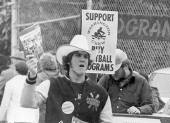 |
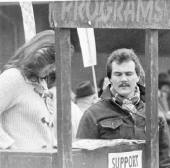 |
Dick
Erickson missed no opportunity to help the VBC raise money for the team, and
in the mid-70's through the mid-80's worked with the Athletic Department for
the club to run the game-program concession at the home football games. Everyone
was expected to participate, with the VBC Purser leading the dollar count and
writing the deposit slip and then - escorted by UW Police - taking the
$20,000+ in cash (mostly ones) to the bank at
the end of the first quarter. 1977 VBC
Yearbook photo. Added 2/23
Left to right, some of the staff that would accompany the team to Henley: Front left: Jeff "Rollo" Benedict, manager, and coach Dick Erickson; Harry Swetnam, Stan Pocock, and Kirk "Lucky" Knapp behind them, with Keith Ikeda in the stern. "Stan was a huge help to us that year" says Mike Hess, twenty-five years later. "He made us focus on the things that were important." Erickson Collection photo/thank you Greg Giuliani.
The Varsity Lightweights, left to right: Tom Bascom, Charles Naden, Brian Martin, Rick Robinson, Don Scales, Skip Miller, Doug Jones, Scott Donaldson, cox Dave Dickhaus. 1977 VBC Yearbook photo.
The JV's, left to right:
Mark Tuller, Mitch Silver, Mike Weight, Mike Pederson, Kris Schoenberg, Roger
Bowlin, Mitch Millar, James Hulbert, cox Keith Ikeda. 1977 VBC Yearbook
photo.
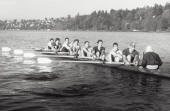 The
1977 JV8 on Lake Washington. HRF Photo
The
1977 JV8 on Lake Washington. HRF Photo
The Dik-mobile. Erickson
returned after a two inch loss at San Diego to find his car had been "adjusted"... complete with dingle-balls
along the interior roofline. He was not happy at the time; but later drove
it home to show Irma. 1977 VBC Yearbook photo.
In the Crow's Nest. 1977 VBC Yearbook photo.
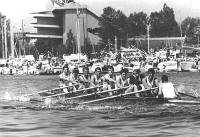 Opening Day 1977: the
Varsity
8 casts them out and reels them back in. 1977 VBC Yearbook photo.
Opening Day 1977: the
Varsity
8 casts them out and reels them back in. 1977 VBC Yearbook photo.
The agony of victory, Opening Day style. 1977 VBC Yearbook photo.
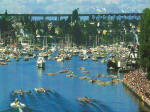 |
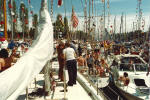 |
 |
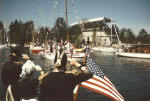 |
Speaking of Opening Day: just some of the colorful spectacle - and wall to
wall watercraft of every shape and size - that was Opening Day, 1977. It was
soon after this that the yachting event and parade became more organized; prior
to that - and including this day in 1977: if you showed up in your boat, you
joined the parade.
Dick Erickson Collection; added 2/21
The connection between the Seattle Yacht Club - located 500 feet from the finish line at the Montlake Cut - and Washington Rowing go way back. In 1910, Hiram Conibear acquired the Alaska-Yukon Exposition Coast Guard Station at the foot of the fair's "Pay Streak" on the northeast shore of Portage Bay for his teams; in 1917 the SYC was doing the same with the property directly across the new Montlake Cut from the VBC, known as the "Casino Grounds" (the planned, but never completed, location of the AYE casino). As the SYC was building their new clubhouse in 1919 (the one still standing today), the VBC was moving into their new home, the Navy Hangar on the east end of the Cut. From that point forward the SYC became one of the strongest community partners with the UW rowing team in the city, and has remained so today.
The one-of-a-kind Opening Day Regatta is a testament to that bond and partnership. But in this photo with the 1977 SYC Royalty, the story is not rowing, but rather the celebration of Seattle quickly becoming a major professional sports city (see the banners in the background). It began with the NBA's expansion with the Seattle Supersonics in 1967, followed in 1974 with the Professional Soccer team Seattle Sounders; followed in 1976 with the NFL expansion Seahawks, and finally in 1977 - when this photo was taken - of the MLB expansion Seattle Mariners. In the span of ten years the University of Washington sports teams - which for decades had an almost perfect monopoly on the local sports pages - would be competing with not just one new professional team representing the city, but four. Dick Erickson, like Hiram Conibear a tireless promoter of the sport and king of the "dog and pony show", was not backing down from the challenge. His response: "On to Henley". Dick Erickson Collection; added 2/21
The Steward's Cup was a holdover from the 60's, often held the week after Opening Day, seen here from the Montlake Bridge on May 14th, 1977. Oregon State - a team that a month earlier had defeated the Huskies on the OSU home Willamette River course - is leading the varsity race by about a seat with 400 meters to go, with the Washington JV and WSU varsity trailing. The Husky V8 would take this race in the sprint, and would go on to defeat Oregon State at Redwood Shores in the final of the Pac-8 Championships a week later (OSU beat Cal in the semis), but this Beaver team is still considered one of the best - if not the best - OSU crews of all time.
Tom Woodman, who became a teammate and friend of many UW rowers on the USA National Team in the 70's and 80's and rowed in the seven seat on this OSU crew, said, "I was a walk on, but had rowed one year before back east, before transferring to OSU as a Junior. Our team was not very deep, but the top guys were dedicated and close. We raised enough money for a new Schoenbrod boat that winter, and had it for the spring season... and at the Steward's Cup we hoped to win again, but UW's final sprint went through us at the very end. The next time we met was at Pac 8's in a brutal headwind, and our light boat was no match to the big guns at UW. And I suspect UW was getting faster as the season went on."
"OSU had a great team that year," said UW stroke oar Mike Hess. "Great
guys and really good rowers and they pushed us hard. A number of those guys
ended up on the National Team, that was the level that team was at. It made for
great racing and a whole lot of pain every time we raced. But it is that
kind of competition that makes you better, and we got better each time we faced
them. I remember in the conference final, the third time we met them that
season after OSU had defeated Cal in the semi... Stan Pocock was standing on
the Redwood Shores starting line saying, 'Use your legs, use your legs!'.
We shot out of there like a cannon... that was the start that we took with
us to Henley." Tom Woodman newspaper clipping; added 2/21
The varsity crew at Henley, bow to stern: Ron Jackman, Mark Sawyer, Ross Parker, Mark Miller, Mark Umlauf, Terry Fisk, Jesse Franklin, Mike Hess, and cox John Stillings. Time/Life photo.
Midway down the course in the Grand Challenge semi-final against Garda Siochana. Terry Fisk, 6-oar, said this years later: "I don't remember a lot of that race other than it was unrelenting. No drama, just a steady grind it out inch by inch, foot by foot race with total concentration the entire course. I think maybe it was the most grueling race I ever rowed because there was no separation... side by side the whole way."
He continued: "I don't know why, but before the semifinal and even going to the start I was convinced we would win. I just had a feeling and I have no idea where it came from or why.... quiet confidence in all of us. But the race did pretty much wreck us for a while. I remember being in awe of Ross Parker and feeling like he in particular had sold everything during that race. Maybe we all did to some degree. We all have our own ways of recovery and for me after that race it was to go deep and still and internal for a long time and think about the pain. To know it would come again the next day and to accept it and even embrace it in advance so during the final it almost had the feel of normalcy, something I could accept and work with and work through and come out the other side."
Dick Erickson's few words captured the depth of it: “My God
they went fast and rowed hard – we threw the book out for this one.”
Time/Life photo.
 |
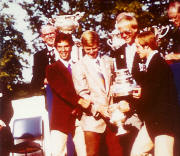 |
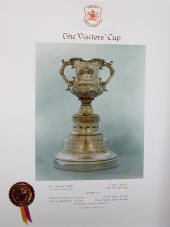 |
Mitch Millar
(stroke), Kris Schoenberg, Skip Miller and Paul Quinney (bow) win the
Visitor's Cup in Washington's first ever victory at the Henley Royal
Regatta. Said Miller after the race, "we told the local pub - where we
have been rationed to one pint of beer a night - that if we won today we'd be
back for five or six pints tonight." 1977 VBC Yearbook photo;
Frances Mast, (crewhouse cook) scrapbook.
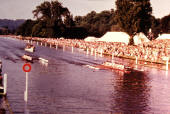 |
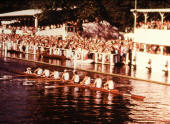 |
 |
The varsity a few strokes
from the finish, and across the line to win the Grand Challenge Cup. This was the first
Washington team to race in an Empacher, rowing in the same shell that the 1974
U.S. National Team rowed to victory at the world championships: the Martini Achter.
To listen to stroke oar Mike Hess describe this race, click here --->
Huskies at Henley, 1977.
(WindowsMedia format) Photos: thank you John Stillings.
Dick Erickson's vision for the program, and the
opportunities he sought for his men, came to full fruition in 1977.
Photos: thank you John Stillings.
![]()
1978
The stunning win at Henley made rowing at Washington very popular both locally and globally. Dick Erickson was quick to parlay that success into an invitation, via the NAAO, to the "Festival of Oars" on the Nile in Egypt in December of '77.
The "Festival of Oars" was an Egyptian tradition of honor dating back thousands of years to the pharaoh Akhanton, and was rekindled in 1971 on the same historical course on the Nile. The event featured two main races, one in Luxor and one in Cairo, and also attracted an international contingent of competitors, with Britain and France sending national teams. As reigning collegiate national champs, the NAAO came first to Erickson with the invitation. Costs were covered by the Egyptian government from London to Cairo, and the Stewards (via an anonymous donor) paid for the trip to London.
All of that added up to a Luxor Regatta that looked great on paper but had some interesting results. The language barrier at the start caused enough confusion that the starter just yelled to start the race, but once rowing there was greater confusion as to the finish line. The French, British, and Washington crews kept rowing, stopping only after the Egyptians, way back of the pack, had stopped. The final results: France by a second over the Brits over the Huskies by a second. But no one is really sure.
Once back home the men got down to the serious business of training for what Erickson was now calling the "Rose Bowl" of rowing - the San Diego Crew Classic April 1st. "It's our only national-level regatta of the year" he said, "it's a pressure race". The freshmen began the day with a strong race down the course, defeating OCC in a nail-biter with a tough sprint. The JV's and lightweights finished third behind winning Pennsylvania crews, setting up the race of the day between Washington, Harvard, and defending champs Penn. The plan was to get ahead early, and that is exactly what they did, building to a half length lead by 1000 meters. The strength and conditioning of the crew then held off a charging Penn, with coxswain John Stillings imploring his crew to "put the hammer down" in the last 300 meters to win by 2.1 seconds in 6:03.1. California finished in third just feet behind Penn, prompting Erickson to say "Cal was much closer than I cared to see."
After continuing to hone his crews, Erickson took the squad to the Estuary on April 29th and swept the Bears at the Dual, including a six length victory by an improving lightweight squad. The JV's and varsity both under-stroked their Cal counterparts through the middle half of the race and used the extra energy to power across the line with open water to spare. The frosh race was the race of the day only because it was the most bizarre; the fin fell off of the Husky shell somewhere before the race, thus rendering the tiller almost useless. Coxswain Gary Evans spent the next six minutes directing his starboard or port sides to ease off to keep the boat from crashing into the docks the length of the estuary. "We were going out of our tree" said Erickson of he and Bob Ernst, watching helplessly in the launch as the freshmen meandered all over the course. Amazingly the crew still won the race by about two seconds.
A week later at Opening Day the wins were decisive by all of the crews entered. The varsity defeated a visiting Oxford crew by multiple lengths of open water, and the varsity lightweights secured victory over a visiting Japanese crew (Tohoku University) - but more surprisingly six seconds ahead of the UBC crew that had defeated them at San Diego a month previous.
All of this was a set-up to the Pac-8 Championships on the Cut two weeks later with a return trip to Henley on the line. On a glorious spring day, the lightweights, freshmen, and JV's all rowed to convincing victories, the frosh winning by over ten seconds over the Bears as compared to their experience on the Estuary in late April. But the reconfigured Bear varsity came to race, and midway through the event had a half length lead. Entering the Cut, the Bears brought their stroke rate up, but the Huskies responded and began to move as the boats went under the Montlake Bridge, the two teams locked in a duel to the death. "Did we win?" asked Mike Hess of cox John Stillings after gaining enough strength to talk. "Yes" said Stillings, and then Hess fell over backward. "I'm under a lot of strain" mumbled Erickson after this rip-up-the-script race by both teams, won by the Huskies by about four feet. Hess's comment afterward: "Everything was hurting. Everything".
The crew was officially Henley-bound, and this time Erickson would take his varsity and a composite boat made up of four JV oars and the stern four of the dominant frosh eight, and two spares. After a week of training at Nottingham, the crews entered a series of races covering two days with mixed results; the composite eight and the pair (Dave McGee/Bill Walker) won their Senior-A races, but both crews dropped alternate events. The varsity, rowing at the Elite I level, lost to the Bulgarian National Team the first day, and the second day finished a surprising fourth behind Bulgaria, France, and IRA winners Syracuse.
Once at Henley the composite crew drew Neptune RC, the only team that had defeated them at Nottingham. Neptune exploded off the start and the Huskies could not track them back down, losing by a length and subsequently knocked out in the first round of the Thames Cup. The varsity drew a bye and then met IRA bronze medalist Northeastern in the semi-final, cruising to a four-length victory. In the other bracket, it was Bulgaria dispatching first the British, and then IRA champion Syracuse by two lengths in their semi to gain entry into the Final.
On July 2nd the final two Grand Challenge crews started the race even, with Washington gaining a surprising lead early but the Bulgarians drawing even by the quarter mile. It was there they turned it on, methodically moving through the Huskies to take a boat length and more. Once at the enclosures, Hess brought the stroke rate up and the crew began to move, closing the open water and then some... but it was too late, with the Bulgarians winning by three-quarters of a length. Defeated by an exceptional eastern-bloc crew, Erickson said "We'll have to reach a long way back to find out what we could have done better."
1978 was a classic Dick Erickson year: two international trips, four separate overseas venues and races, an undefeated regular season for the varsity and a dominant freshmen squad. But it was also clear from the San Diego and Pac-8 results that the collegiate rowing scene was growing increasingly competitive, particularly on the west coast. In that atmosphere - and with leaders like Hess, Umlauf, and Stillings graduating - Erickson had to know the "strain" he was under was probably not going away.
In the summer of 1978, Chris Allsopp rowed in the double at the World's, finishing 5th.
Dick Erickson, 1978. UW Rowing Photo, added 2/23
At Giza in December of '77, the team left to right (back): Lewis Hiatt, Mark Sawyer, Roger Bowlin, Mark Miller, Bill Hubbard, Bob Umlauf, Terry Fisk, Dave Magee; front: Bill Walker, Tommy Damm, Chris Dern. Husky Crew photo.
Erickson could walk on water after the '77 season. Husky Crew photo.
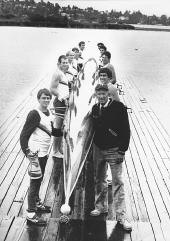 The
Varsity 8 rowing the Cadillac version of the Pocock cedar shell. UW Rowing
photo
The
Varsity 8 rowing the Cadillac version of the Pocock cedar shell. UW Rowing
photo
Dick Erickson knew just about everyone in the Seattle maritime industry - or at least it seemed that way - and throughout the mid to late 70's and early 80's, if the opening froze over for any length of time, he would have his friends from the Army Corp of Engineers bring the W.T. Preston in to break the ice. The Preston was a stern-wheeler "snagboat", commissioned to remove debris from the commercial waterways in and around Puget Sound. Retired in 1981, she now serves - pulled up on land - as a restored maritime museum in Anacortes, Washington. The W.T. Preston - Wikipedia
The other half of this story is the re-commissioned lifeboat, (manned likely by freshmen) assisting the Preston in clearing the ice. Suffice it to say the story of this craft is too long to tell here, other than it had a re-fitted DeSoto engine and required a crew of two (1 to steer/1 to shift) while underway. But on this particular day, all it needed was oars: "Rowing out of there was like rowing in a cocktail," said Erickson. George Teasdale photo; added 2/21
The "Moms" of Conibear:
Frances, Vera, and Pat. The food at the shellhouse in it's heyday was
excellent thanks to these ladies - and a budget, particularly in the fall when the
men shared the training table with the football team - that included T-bone
steak (Tuesday) and Prime Rib (Thursday) once a week for dinner. Husky Crew photo.
The ergs moved outside in the spring, from their regular home in the dark, musty, dilapidated launch moorage shack that - inside - resembled a medieval torture chamber. Husky Crew photo.
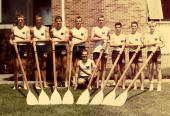 |
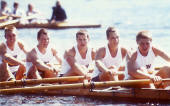 |
The Class of '81 remains one of the strongest classes in the
history of the program, undefeated as freshmen with multiple future National
Team members (Felix, Clapp, Zevenbergen, Carter). From left to right in
far photo: Marius Felix (stroke), Charlie Clapp, John Zevenbergen,
Frank Davidson, Dave Lauber, Scott Carter, Mike Crustello, Jan Janjic,
with Gary Evans as cox. Near photo: the stern five on Opening Day.
Dick
Erickson Collection; added 2/21
The varsity accepting the Copley Cup after a tough race against Pennsylvania at San Diego. Left to right: Mike Hess, Mark Sawyer, Mike Peterson, Greg Guiliani, Mark Miller, Terry Fisk, Kris Schoenberg, Brian Martin. In front is Erickson with the Cup, shaking hands with a race official, with John Stillings looking on. Husky Crew photo.
The composite crew straining to
catch Neptune RC in the Thames Cup at Henley, left to right: James Shinbo (cox),
Marius Felix (fr), Charlie Clapp (fr), John Zevenbergen (fr), Frank Davidson (fr),
Dave Kehoe, Paul Barker, Lewis Hiatt, Eric Watne. Husky Crew photo.
The varsity about 100m into the final against Bulgaria on the Henley course. The night before this race, Mike Hess said in an interview: "We have to go fast. Faster than last year, faster than we've ever gone. Every time we've done a practice this week I've been thinking, 'How was it last year? What did we do right then? Are we faster?'" (1)
They may have been. Bulgaria was that good. Sports Illustrated; added 2/21
1) Sports Illustrated; "Bulgaria Is
No Bunch of Slavs"; Dan Levin, July 10, 1978; Pg 71-74
![]()
Rowing in the same boat with future Hall of Famers like Hess and Umlauf was elusive for guys like me, except on those days when Dik rounded up a ham n egger. Among the joys of rowing in the Fall – no upcoming race pressure, great weather, steak dinners with the football team, stretching on the lawn while the cheerleaders worked out on the practice field – there was perfect ecstasy in pulling your guts out for pride, wanting to live up to the amazing luck of having your tongue blade dug out of the hat along with Mort’s.
Crossing Union Bay for warm-up – faces in the blazing setting sun – was smack-talk time. “Hey Walker, lemme know when you can beat your girlfriend on the erg” earned a wadded-up ball of gazortins in the side of the head, on and on… til we reached the bridge and powered up for the final swing before the start. Turning around at Medina and lining up at the East high rise, a last “hasta luego, Dago” or “hey Fisk, we racing for soft-shell tacos?” – “you sure you can handle that, Kebo?” then “Ready all? Row!” and the boat was swinging, whoop-glide, whoop-glide, and DAMN, so this is what it’s like. For a few golden moments George Pocock really meant it, and we really did go faster with every stroke. Stronger, smoother, 20 at 1000, rush-hour traffic honking, Dik and Rollo pulling up alongside, no comment, just watching. Your coxswain counting down the seats in the next boat, up to the bow ball and open water, screaming for more with 500 to go, lungs exploding, thighs on fire, wanting it to end but go on forever. All for bragging rights at dinner.
Easing toward the Connie with the sunset behind your back, haze on the glassy water and a big full moon coming over the hill, you hear the word “idyllic” used in a real sentence for the first, and maybe only, time in your life. “Shit guys, what an idyllic setting we have here tonight. What the hell, why waste it? Line em up and race em back to the boat house!”
Bill Walker '79
![]()
1979
Bob Ernst, with graduate assistants Paul Quinney and Don Scales, welcomed in another huge class of freshmen at the crewhouse on the first day of school in 1978, and within days the men were worked into shifts out in Old Nero. The varsity squad began turnouts in anticipation of another trip to the Nile in December, with competition already heating up for the four varsity seats left open from graduation.
A team of eleven athletes accompanied by Erickson and Ernst made the trip to Luxor and Cairo. The men won their race at Luxor by two lengths and followed that up with a one and a half length win in Cairo over British, Irish, Egyptian, Canadian and Belgian competition. Highlights of the trip included the festival of oars (a parade and ceremony for the athletes) in Luxor and visits to the pyramids and Great Sphinx at Giza, before returning home.
Class Day capped two-a-days over spring break, with a fully returning class of '81 sophomore boat leading the seniors by a half length at the finish. All of that augured well for a return trip to San Diego for the opening of the season the following week. But once in San Diego the wheels began to fall off, especially when veteran varsity oar Brain Martin was pulled out of the bow seat the day before the races due to a flu-like illness that had infected the squad (replaced by a JV member). The varsity, with other members fighting the bug, could not recover the next day, finishing fourth in their heat and failing to make the final (won by Harvard followed by Cal) for the first time at San Diego. "We crashed" said an uncommonly pale Erickson.
The JV's, now rowing with a member who was also rowing in a club event, finished fifth. The only salvation for the day came from the lightweights and the freshmen, both winning their events; the freshmen after catching a boat stopping crab in the last 500 meters, cranking it back up, and winning by 3/4's of a length over OCC. But a quiet trip home reflected the shock in the squad. "The onus is on us now", said Erickson, "California has a helluva crew and they'll be real tough".
Four weeks of training and northwest racing - and the opportunity to get healthy - had a re-vamped varsity ready to face California on Opening Day, May 5th. But Cal, with what Steve Gladstone was now calling "the best crew I've had", was back on the Cut less than a year after losing by mere feet and were looking for vengeance. The crews battled through the first 500 meters almost even, but California took a burst - increased the stroke rate midway through the race - and in about twenty strokes had moved to a 3/4 length lead that they never relinquished. In fact by the finish the lead had grown to over a length, and California won for the first time on Lake Washington since 1965. "That's the best race we've rowed all year" said an excited Gladstone. The JV's fared no better, finishing a length behind Cal, but the freshmen and lightweights again defeated their Bear counterparts convincingly.
1979 would be the first year of the "Pac-10" (Arizona and Arizona State joining in the fall of 1978) and the first year that the conference championships would be permanently established at the Redwood Shores course south of San Francisco. The team, after two-weeks of deliberate and intense workouts, saw the Pac-10's as their last chance at redemption for the year and were confident they could do it. "We've got to do something to turn (this) around" said Erickson. "They're a good crew, there's no doubt about it. But we're a good crew too."
True to Erickson's word, Washington would break the course record in the finals on May 19th, but it was California finishing the race three seconds faster in 5:53.62, completing their season with only the loss to Harvard at San Diego and sending them off to Henley. "My hat is off to California" said Erickson after the race.
The year finished as a wake-up call to a program that had sat on the top rung of west coast rowing for the better part of a decade. California was back with a vengeance. The narrow win by the Huskies on the Cut in 1978, accomplished in part through the last ten stroke heroics of four now graduated world-class athletes, suddenly, in hindsight, looked more significant. California was on top and for good reason: as Erickson noted, Steve Gladstone had a "helluva crew" - and it did not look to be changing anytime soon.
In the summer of 1979, the following Washington oarsmen made the U.S. Pan Am team: Chris Allsopp, 2x, silver; Jesse Franklin, 4-, silver; Fred Fox and Mark Miller, 4+, bronze; Bruce Beall 4x (quad), bronze; Mike Hess, 8+, gold. The following made the World team: Dave Kehoe, 4-; Chris Allsopp, 4x; Mike Hess 8+.
The team at the festival of oars, front to back: Mark Allison, Terry Fisk, Mark Miller, Marius Felix, Charlie Clapp, John Zevenbergen, Frank Davidson, Mike Peterson, Brian Martin, Greg Guiliani, John Wunsch. Dick Erickson Collection photo.
Rowing past the Cairo Tower (about the height of the Space Needle), Washington begins to open up a lead on the rest of the field. Dick Erickson Collection photo.
Washington is to the far right
in this picture rowing up the Nile. The men brought their own food with
them (particularly peanut butter and honey or jam) on these trips, the main rule
being if you can't peel it, don't eat it. Other teams - that did sample the
food in Luxor - often were not found at the starting line once the crews got to
Cairo. Dick Erickson Collection photo.
The freshmen at the naval barracks in San Diego prior to their first race, left to right Greg Hoffman, Al Forney, Al Erickson, Bob Schwartz, Charlie Van Pelt. The team slept in the open room barracks on 40's era bunks, and ate in the mess halls with the cadets. WRF photo.
The Class of '82, left to
right: Brad Schock, Al Erickson, Bob Schwartz, Charlie Van Pelt, Greg
Hoffman, Al Forney, Dave Worthen, John Menefee, Eric Cohen (cox). Brad Schock photo.
The 1979 Lightweight team. WRF photo.
One of the bright spots of 1979 and a harbinger of things to come, the freshmen winning over California on Opening Day. Brad Schock photo.
Freshmen coxswains Eric Cohen and Lisa Horn hit the drink after the Pac-10's. Brad Schock photo.
Freshmen Coach Bob Ernst takes a bath at the expense of his undefeated crew at Redwood Shores after the Pac-10's. Brad Schock photo.
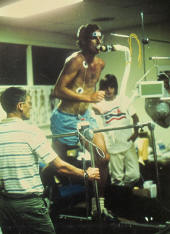 |
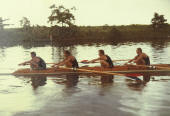 |
 |
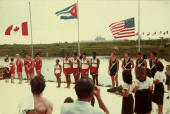 |
The 1979 Pan Am Games were held July 1st - 15th 1979 in San Juan, Puerto Rico, and the above photos are all from Fred Fox's scrapbook. Fred - who rowed bow in the USA 4+ - earned a bronze medal with UW teammate Mark Miller, Cuba taking the gold. On the left in the photos above is the U.S. training camp with Fred on one of the first Vo2Max treadmills, a nascent technology in 1979 that measured the amount of oxygen an athlete uses at maximum effort (and is a measure of cardio fitness). Today similar tests are run, but without the medieval torture setup that these athletes endured. Fred Fox scrapbook; added 2/21
![]()
Sources for the 70's: University of Washington, The Tyee, 1971; Wood and Water, 1973 VBC yearbook; Rowing a Race is an Art, 1977 VBC yearbook; VBC Log Book, 1969-1973, MSCUA; VBC Log Book, 1974-1981, MSCUA; The Log of Rowing at the University of California, 1870-1987, Jim Lemmon; Ready All! George Yeoman Pocock and Crew Racing, Gordon Newell; "Way Enough", Recollections of a Life in Rowing, Stan Pocock; Sports Illustrated, 6/71; The Seattle Post Intelligencer, various articles (specifics available on request); The Seattle Times, various articles (specifics available on request); A Short History of American Rowing, Thomas Mendenhall; www.Rowinghistory.net, U.S. Team Boatings; Files from the Dick Erickson attic; Conversations/interviews with Mike Hess, George Teasdale, Cliff Hurn, Irma Erickson, Dwight Phillips, and Dee Walker.
Thank you VBC Loggers, Irma Erickson, The Seattle Times and Seattle Post Intelligencer for providing the balance of information for these years.
| Home | Contact Us | © 2001 - 2023 Washington Rowing Foundation |